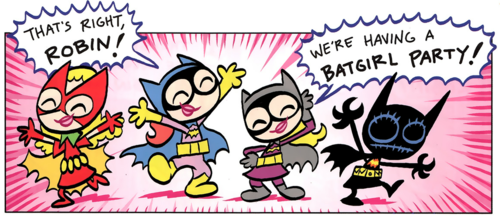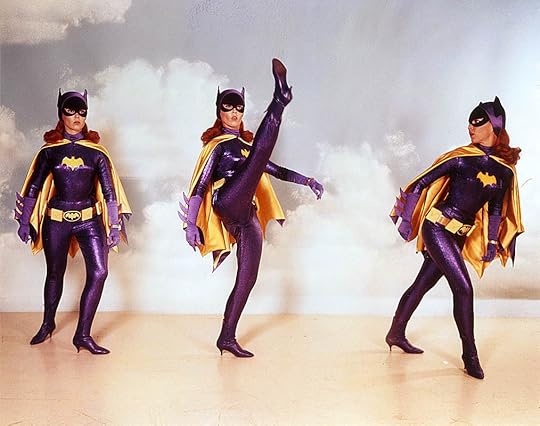Tansy Rayner Roberts's Blog, page 104
August 10, 2012
Where the Wonder Women Are: #16 Ice
 It’s so hard to write about Fire and Ice as separate characters rather than as a pair! They go together like cheese and chutney. But they are very much individuals, and two of my favourite comic book characters of all time, so I will do my best to tell their separate stories (with of course lots of references back and forth).
It’s so hard to write about Fire and Ice as separate characters rather than as a pair! They go together like cheese and chutney. But they are very much individuals, and two of my favourite comic book characters of all time, so I will do my best to tell their separate stories (with of course lots of references back and forth).
What surprised me was when I realised that Ice (Tora Olafsdotter) has the stronger storyline, and is actually the dominant member of the duo, from a narrative point of view. Fire is the one with the big power and big personality, but Ice… well. Ice has hidden depths.
Oh, and she’s the first major Justice League International member I have written about for this series which means this one’s kinda long. Sorry. You know it’s the best comic series ever written, right?
The Global Guardians were a super team who had their origins in the Super Friends cartoon, which attempted to create several superheroes who represented different cultures and ethnicities, and add them to the Justice League line up. Later, in the comics series DC Presents in 1982, some of these characters were presented as part of a larger, multicultural super team. Along with heroes from Australia, Japan, Israel, South Africa, Germany, Taiwan and all manner of countries, the Global Guardians included Green Fury/Green Flame of Brazil (Beatriz DaCosta) and Icemaiden of Norway (Sigrid Nansen).
In 1987, Keith Giffen, J. M. DeMatteis, and Kevin Maguire created a new version of Justice League. Set straight after Justice League Detroit was trashed, and at a time when most of the Big Gun characters in the DC Universe were undergoing some kind of reboot, relaunch or revival, this new team created a Justice League with a more international flavour, and a lighter tone.
 Minor and forgotten characters were dusted off and given livelier personalities; banter and sarcasm became the order of the day, and legends were made. The main difference between this and previous versions of the League was the corporate role of Maxwell Lord, a businessman whose patronage meant that for nearly a decade, the story of the Justice League would be one that actually examined the bureaucracy and management needs of a super team. The United Nations were also brought into the mix, meaning that members of the Justice League earned a wage, paid fire insurance, and had to justify their expenses as well as abiding by international conventions – and yes, it was an administrative nightmare. That’s where half the comedy came from! This era is unofficially known as the “Bwa-ha-ha Era” of the league because of how the characters often made each other laugh uproariously.
Minor and forgotten characters were dusted off and given livelier personalities; banter and sarcasm became the order of the day, and legends were made. The main difference between this and previous versions of the League was the corporate role of Maxwell Lord, a businessman whose patronage meant that for nearly a decade, the story of the Justice League would be one that actually examined the bureaucracy and management needs of a super team. The United Nations were also brought into the mix, meaning that members of the Justice League earned a wage, paid fire insurance, and had to justify their expenses as well as abiding by international conventions – and yes, it was an administrative nightmare. That’s where half the comedy came from! This era is unofficially known as the “Bwa-ha-ha Era” of the league because of how the characters often made each other laugh uproariously.
12 issues in, with UN approval, Justice League became Justice League International and two former Global Guardians were introduced to the team: Green Flame and Icemaiden. Due to a research error, the writers of JLI believed that Icemaiden’s real name had never been mentioned, and so they felt free to create their own identity for her: Tora Olafsdotter, ice goddess.
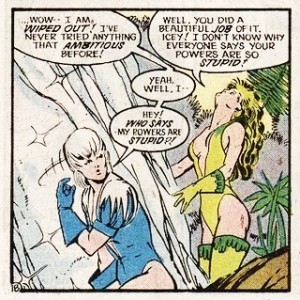 From the moment they appeared on the page, Bea and Tora were a double act: the comedy of opposites. Bea was outgoing, flirtatious and confident, while Tora was quiet, shy and kind. Bea was a born hustler; Tora was her conscience. They were the perfect BFF, often bouncing into I Love Lucy slapstick territory – Bea would get them into scrapes with her big plans, while Tora saved their bacon with grace and tact.
From the moment they appeared on the page, Bea and Tora were a double act: the comedy of opposites. Bea was outgoing, flirtatious and confident, while Tora was quiet, shy and kind. Bea was a born hustler; Tora was her conscience. They were the perfect BFF, often bouncing into I Love Lucy slapstick territory – Bea would get them into scrapes with her big plans, while Tora saved their bacon with grace and tact.
Joining the Justice League was Green Flame’s idea after the Global Guardians lost their funding, and it was clear from the start that both Beatriz and Tora were motivated from the pragmatic need to pay rent than any heroic desires. Within only a few issues, though, they had rebranded themselves as Fire and Ice, and were to remain at the central core of the team for many years to come. They also changed their costumes, Ice swapping her unimaginative frosted swimsuit for something far more modest and reflective of her personality.
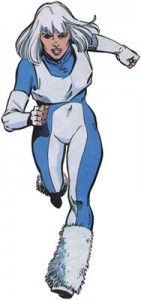 Ice came to represent the moral voice of the team as a whole, and formed great friendships with many of her teammates, especially those hapless slapstick merchants Blue Beetle and Booster Gold, though of course Fire always came first. One of her biggest ongoing relationships was a weird, utterly fascinating unromance with Guy Gardner, a Green Lantern who had been revamped for this comic into a belligerent, sexist and obnoxious thug. Talk about comedy of opposites!
Ice came to represent the moral voice of the team as a whole, and formed great friendships with many of her teammates, especially those hapless slapstick merchants Blue Beetle and Booster Gold, though of course Fire always came first. One of her biggest ongoing relationships was a weird, utterly fascinating unromance with Guy Gardner, a Green Lantern who had been revamped for this comic into a belligerent, sexist and obnoxious thug. Talk about comedy of opposites!
When Ice joined the Justice League, Guy was still suffering from one of a series of “comedy” brain injuries, which meant that her first impression of him was that of an adorable Softypants who loved animals and was kind to small children. This was sadly a massive misrepresentation, and when the real (horrible) Guy re-emerged after yet another blow to the head, Tora continued to have faith that he was, underneath it all, a good person.
She was, of course, wrong. But it was mostly fun seeing him trying (and rarely coming close to succeeding) to live up to those ideals. To Fire’s horror, Ice often gave Guy the benefit of the doubt, and experimented with dating him. While she was rarely rewarded for the trust she placed in Guy, she also would not let him get away with any kind of double standard, such as being on his best behaviour for her but then treating someone else rudely. While the writers flirted with the idea of them making a stable couple someday (including visions of the future in which they are married), and occasional declarations of love, it never quite transitioned into an actual relationship.
 One of my favourite Ice-and-Fire stories has Bea and Tora stranded in a European country without the plane fare home. Rather than admit to the League that they need help, they enter a back alley beauty contest to win the money. While Bea is in her element, dumbing herself down for the questions and stripping down to a teeny weeny bikini, Tora refuses to compromise herself and her feminism for the sake of money. So she seriously addresses the ‘world peace’ question through an informed political speech (with charts!) and finds humorous ways to survive the indignities of the other sections including the talent contest and swimsuit contest. Bea’s ego is seriously wounded when Tora actually wins first prize, and the fact that the contest turns out to be run by aliens who are looking for superior qualities in a mate does not make her any less offended! But of course she comes to her friend’s aid, green fire blazing.
One of my favourite Ice-and-Fire stories has Bea and Tora stranded in a European country without the plane fare home. Rather than admit to the League that they need help, they enter a back alley beauty contest to win the money. While Bea is in her element, dumbing herself down for the questions and stripping down to a teeny weeny bikini, Tora refuses to compromise herself and her feminism for the sake of money. So she seriously addresses the ‘world peace’ question through an informed political speech (with charts!) and finds humorous ways to survive the indignities of the other sections including the talent contest and swimsuit contest. Bea’s ego is seriously wounded when Tora actually wins first prize, and the fact that the contest turns out to be run by aliens who are looking for superior qualities in a mate does not make her any less offended! But of course she comes to her friend’s aid, green fire blazing.
Famously, the Justice League International (which by now included spin off title Justice League Europe) “stopped laughing” when Maxwell Lord was shot. In fact, the comedy of the team had been balanced with drama and violent emotion as early as 1990, when Despero (the alien embodiment of hate who had destroyed Justice League Detroit) returned and killed the family of retired teen superhero Gypsy, then went after the league itself. But the “Bwa-ha-ha Era” certainly ended with the “Breakdowns” arc which stretched across the JLI and JLE titles for more than six months, building on one devastating challenge after another: first the shooting of Maxwell Lord which left him in a coma, then the United Nations bringing in a new manager who fired multiple members including Ice and Blue Beetle, the Armageddon event which culminated in the “death” of JLE leader Captain Atom, the UN revoking the charter of both super teams, Dreamslayer and the Extremists taking control of Max Lord’s body, and finally Despero again. I may have missed a few there.
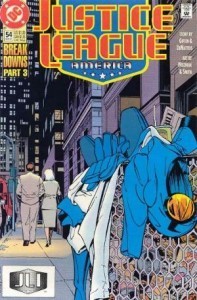 After Ice and Beetle were fired (he for lack of fitness, she for being too sensitive), they refused to give up and were among the core of members who came together at the end, determined to continue being superheroes despite lack of official government sanction. “Breakdowns” also brought mention of Tora’s family, whom she referred to only as “the ice people,” a reclusive but vulnerable race in the mountains of Norway. Their story was expanded in a ‘Secret Origins’ comic which revealed Tora to be truly a goddess, daughter of the Lord of the Ice People, and that because she was female, she was prevented from using her magic at home, or participating in any way other than as the getting-married-and-having-children princess duties.
After Ice and Beetle were fired (he for lack of fitness, she for being too sensitive), they refused to give up and were among the core of members who came together at the end, determined to continue being superheroes despite lack of official government sanction. “Breakdowns” also brought mention of Tora’s family, whom she referred to only as “the ice people,” a reclusive but vulnerable race in the mountains of Norway. Their story was expanded in a ‘Secret Origins’ comic which revealed Tora to be truly a goddess, daughter of the Lord of the Ice People, and that because she was female, she was prevented from using her magic at home, or participating in any way other than as the getting-married-and-having-children princess duties.
By the end of the Breakdowns storyline, J.M. DeMatteis left the series, paving the way for new writers to put their own mark on the team. Justice League International became Justice League America. Dan Jurgens took over the writing for a little over a year, bringing Superman in as leader of the America team. He was also writing for one of Superman’s own titles at the time, which meant that the Justice League were given a front seat to the Doomsday action, forming collateral damage in the famous fight that killed Superman.
Ice developed a crush on Superman, who embodied the heroic ideal to her. This had the added benefit of annoying the hell out of Guy Gardner (who still thought of her as his girl) and showing her independence from him. In the battle with Doomsday, as her friends fell around her, Ice was the one who stayed on her feet, showing how tough and capable she could be. In the aftermath, as Lois Lane sat weeping over her fiancé, it was Ice who covered his face discreetly with the ripped remains of his cloak, and later an ice sculpture of him at the Justice League Embassy as many past and present members of the League gathered in mourning.
Superman returned from the dead six months later, and yet it took even longer for the Justice League to fully recover from the battle with Doomsday. Fire’s powers had been drained in the battle, and she faced the possibility that she might never get them back. Booster Gold’s futuristic costume (which contained all of his power) had been destroyed. Worst of all, Blue Beetle had been so badly hurt that he lay in a coma.
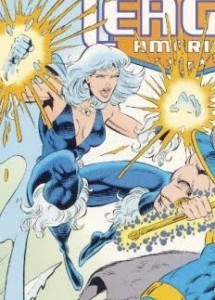 A devastated Tora decided it was time to return home to the city of the ice gods in Norway. There, she not only proved her edginess by taking on a new, sexier costume (“more regal” apparently means “more cleavage”) but also discovered that the patriarch she had run away from was now a shadow of his former self, an old man manipulated by her ambitious little brother Ewald.
A devastated Tora decided it was time to return home to the city of the ice gods in Norway. There, she not only proved her edginess by taking on a new, sexier costume (“more regal” apparently means “more cleavage”) but also discovered that the patriarch she had run away from was now a shadow of his former self, an old man manipulated by her ambitious little brother Ewald.
It all went a bit Game of Thrones after that, with Ewald killing their father (who had threatened to drop his previous sexist attitudes and make Tora, as his firstborn, the heir) and imprisoning Tora. When she called for help, a much diminished Justice League came to rescue her: including a Guy Gardner who was furious at his teammates for not realising his robot replacement wasn’t him even when it committed coldblooded murder, and the no-longer-in-coma Blue Beetle who had now lost faith in his abilities as a superhero, but managed to rebuild several new prototypes of armour for Booster, and create a blaster gun or two for the still-depowered Fire.
Despite the gang coming to her aid, Tora rescued herself. Determined to avenge her father’s death, she fought her brother and broke the mysterious staff that had expanded his powers. Ewald was killed in the resulting explosion.
While her mother begged her to stay behind and take up her father’s throne, Tora wanted to return with her friends to the Justice League, and felt that the best way forward for her people was to elect their own leaders. She still loves politics! (As it happened, the person that her people ended up electing was Tora’s mum, which isn’t a brilliant stab in the direction of democracy, but seemed to work out from a feminism point of view)
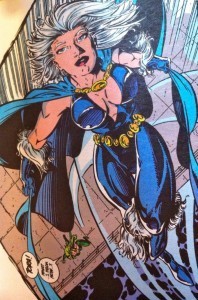 All this had changed Tora: not only the grief she felt for her father, and the fact that she had basically killed her brother, but physically as well. It didn’t help that the art style of the book changed at this point, rendering her (and everyone else) extra angsty and melodramatic. The extra powers that Tora’s brother had taken from the staff now manifested in her, giving her super-strength and the ability to fly. No one would ever say that Ice was the weakest team member now! (though um, some of us never thought that about her anyway) At the same time, she began to distance herself from those closest to her, especially Fire and Guy.
All this had changed Tora: not only the grief she felt for her father, and the fact that she had basically killed her brother, but physically as well. It didn’t help that the art style of the book changed at this point, rendering her (and everyone else) extra angsty and melodramatic. The extra powers that Tora’s brother had taken from the staff now manifested in her, giving her super-strength and the ability to fly. No one would ever say that Ice was the weakest team member now! (though um, some of us never thought that about her anyway) At the same time, she began to distance herself from those closest to her, especially Fire and Guy.
If you’ve read all the essays so far, and particularly the one on Jean Grey, you can probably tell where I’m going with this. Rapidly expanded powers, odd mood swings… uh oh!
Yes. Ice was killed. After turning evil, no less!
A villain called the Overmaster who had been responsible for a great many artefacts like Ewald’s staff, called in the favour that Tora had never known she had received from him, and took control of her mind. She joined his Cadre as a villainous sidekick and fought her friends and colleagues until the Martian Manhunter used his psychic abilities to appeal to her heart and remind her who she really was. She promptly led the charge against the Overmaster, and was obliterated by him.
 Mark Waid, who wrote those issues, later talked about his regrets about killing Ice, especially in light of the long, long list compiled on the Women in Refrigerators website, of women who were damaged and killed in the comics universe:
Mark Waid, who wrote those issues, later talked about his regrets about killing Ice, especially in light of the long, long list compiled on the Women in Refrigerators website, of women who were damaged and killed in the comics universe:
He was certainly right that Ice’s death would provoke a visceral response. Tora’s death sent shockwaves through this version of the Justice League, which never entirely recovered from her loss. Fire (whose powers had returned in her fury at the death of her friend) was devastated, as was Guy Gardner, and the ghost of Tora (in some cases, literal) haunted both of them for many, many years. Blue Beetle and Fire’s friendship broke irretrievably because they disagreed about how to handle the publicity surrounding Ice’s death. The League itself fractured into new teams, based on who could stand to be in each other’s company.
 During the last gasp of this version of the League, it appeared for a moment as if Ice might have returned, but it was instead the first Icemaiden, Sigrid Nansen, attempting to honour her namesake. She joined the Justice League and formed a friendship with Fire, to the disgust of Guy who refused to accept a replacement for Ice. I think it’s also worth mentioning that the idea that there was any romantic attachment between Fire and Ice, or that their intense friendship was anything other than platonic, became an ongoing narrative theme after Tora’s death and was particularly shown with Sigrid, who fell in love with Fire, but also implied in many of the Guy-and-Fire-work-out-their-Tora-issues stories that turned up from time to time.
During the last gasp of this version of the League, it appeared for a moment as if Ice might have returned, but it was instead the first Icemaiden, Sigrid Nansen, attempting to honour her namesake. She joined the Justice League and formed a friendship with Fire, to the disgust of Guy who refused to accept a replacement for Ice. I think it’s also worth mentioning that the idea that there was any romantic attachment between Fire and Ice, or that their intense friendship was anything other than platonic, became an ongoing narrative theme after Tora’s death and was particularly shown with Sigrid, who fell in love with Fire, but also implied in many of the Guy-and-Fire-work-out-their-Tora-issues stories that turned up from time to time.
1996 rolled around, and the last vestiges of this version of the Justice League (including four linked titles at the time) were dropped in favour of a revamped team written by Grant Morrison, made entirely of the ‘big gun, has own book’ original Justice League characters from the Silver Age. I remember being particularly disappointed that only one woman (Wonder Woman, of course) featured in the initial line up. While Morrison did later bring in some great less famous characters such as Huntress, Big Barda, Steel and Oracle (though frankly he loses a million points for including Plastic Man), there was a notable absence of certain characters who had represented the heart of the Justice League for the previous nine years. And I stopped reading.
Several years later, Giffen, DeMatteis and Maguire produced a funny 6 issue mini-series, the Eisner-Award-winning “Formerly Known as the Justice League” (2003) which featured many of the old JLI and JLE characters such as Maxwell Lord, Fire, Beetle, Booster, Guy Gardner, Elongated Man and Sue Dibny, brought together as a super team calling themselves the Super Buddies. Lacking the presence of Ice, the new lineup introduced Mary Marvel, a character who radiated innocence and sweetness. The sequel, “I Can’t Believe It’s Not Justice League,” (2005) incorporated the ghost of Tora in an Orpheus-style storyline.
Also in 2005, “Countdown to Infinite Crisis” was published, a much darker one-shot comic detailing Blue Beetle’s investigations into the true criminal (and megalomaniac) nature of Maxwell Lord, which ends with Max murdering Beetle to keep his secret. Wonder Woman later killed Max execution-style to stop his relentless mind-manipulations. Between all this and the 2004 series Identity Crisis (I know, a lot of Crises!) which had Sue Dibny killed and retrospectively raped, people were seriously starting to wonder if someone at DC had a grudge against the Super Buddies and their comic of origin.
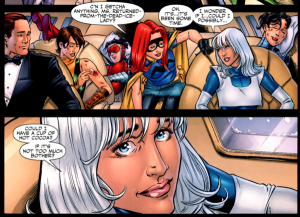 In 2007, Gail Simone brought Ice back. Because she is awesome.
In 2007, Gail Simone brought Ice back. Because she is awesome.
On a mission which united the Birds of Prey and the Secret Six, the two teams that Simone wrote for at DC, an “ice princess” and “goddess” was resurrected by Creote, one of the Birds of Prey allies who intended to use her for his own political gain. Furious upon her awakening, Ice went on the warpath but was eventually subdued and reunited with her friends. JOB DONE.
But what to do with her next? No one seemed to have much in the way of a plan.
 Ice appeared sometimes in the Checkmate comic which now featured Fire as a military operative, and occasionally in the Green Lantern comics as Guy Gardner’s sometimes-girlfriend, but only tended to be given serious plot time when she could be used as a villain who attacks her friends – first as a “Justifier” in the Final Crisis event and later as a Black Lantern (angry zombie ghost person) during the Blackest Night event. She could be a useful supporting character as long as Fire or Guy had their own title, but did not really have a place of her own – and nearly everyone who picked her up seemed more interested in portraying her anger/power issues than recapturing anything of her previous personality.
Ice appeared sometimes in the Checkmate comic which now featured Fire as a military operative, and occasionally in the Green Lantern comics as Guy Gardner’s sometimes-girlfriend, but only tended to be given serious plot time when she could be used as a villain who attacks her friends – first as a “Justifier” in the Final Crisis event and later as a Black Lantern (angry zombie ghost person) during the Blackest Night event. She could be a useful supporting character as long as Fire or Guy had their own title, but did not really have a place of her own – and nearly everyone who picked her up seemed more interested in portraying her anger/power issues than recapturing anything of her previous personality.
Then in 2010-11, Geoff Johns and Peter Tomasi wrote the mostly excellent 24 issue limited series Justice League: Generation Lost. The story revolves around Max Lord, returned from the dead (again) who sets off a brain-wiping virus to make the world forget about his existence – everyone except his former JLI colleagues Fire, Ice, Booster Gold and Captain Atom. A cat and mouse game ensues, in which Max uses all of his powers and wealth to denigrate the reputation of the handful of people who remember who he is and what he has done.
 Tora is marvellously showcased in this series, which captures everything that was important about the character: her good heart, her cleverness, her perfectly balanced friendship with Fire and not-quite relationship with Guy Gardner, her loyalty to the League, and her untapped ice powers. The fact that she actually had spent some time dead is acknowledged both by the story and by Ice herself – we see at the beginning how hard she is finding it to fit back in to the real world, and when asked what death was like she replies, “Cold.” Once again, though, the story revolves around her having wild, uncontrollable powers, and sometimes attacking her friends, which seems to be a core theme of the new, post-death Ice. Almost as if the writers are uncomfortable with a female superhero who is just plain nice?
Tora is marvellously showcased in this series, which captures everything that was important about the character: her good heart, her cleverness, her perfectly balanced friendship with Fire and not-quite relationship with Guy Gardner, her loyalty to the League, and her untapped ice powers. The fact that she actually had spent some time dead is acknowledged both by the story and by Ice herself – we see at the beginning how hard she is finding it to fit back in to the real world, and when asked what death was like she replies, “Cold.” Once again, though, the story revolves around her having wild, uncontrollable powers, and sometimes attacking her friends, which seems to be a core theme of the new, post-death Ice. Almost as if the writers are uncomfortable with a female superhero who is just plain nice?
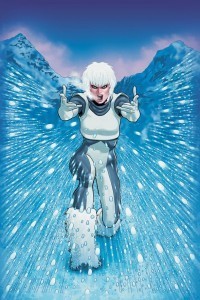 A weird inclusion is a new backstory for Tora. It’s not clear whether this cancels out her magical ice castle family as revealed in the storyline that led to her death, or if it’s compatible, but here she talks about a childhood on the run with a family of grifter gypsies, and how her developing ice powers ultimately meant that her parents gave her up to her grandfather (who might, if squinted at, be the old white-bearded man she previously called her father). While this new backstory could be seen as more “realist,” it makes no sense to anyone familiar with Tora’s previous origin. Also I’m pretty sure that it’s not okay to tell thieving gypsy stories any more, just saying.
A weird inclusion is a new backstory for Tora. It’s not clear whether this cancels out her magical ice castle family as revealed in the storyline that led to her death, or if it’s compatible, but here she talks about a childhood on the run with a family of grifter gypsies, and how her developing ice powers ultimately meant that her parents gave her up to her grandfather (who might, if squinted at, be the old white-bearded man she previously called her father). While this new backstory could be seen as more “realist,” it makes no sense to anyone familiar with Tora’s previous origin. Also I’m pretty sure that it’s not okay to tell thieving gypsy stories any more, just saying.
At the end of Generation Lost, the team are together, beaten but not bowed, and Batman suggests to Booster Gold that the answer is to bring back Justice League International. Which, based on this re-introduction to the characters, could have been amazing.
But it wasn’t. I’m not going to rant extensively about the New 52 Justice League International again, because I did it for the Vixen post, and I’m going to do it again for the Fire post. But when it came to Ice, we got the least possible interesting interpretation of the character, the shallowest possible interpretation of her relationship with Guy Gardner, and dialogue that showed the writer had no interest in her personality. Which might have been forgivable if the writer in question was not Dan Jurgens, who wrote her just fine nearly twenty years ago.
 The last issue I read of the New 52 JLI had Ice (and Fire, and Vixen) comatose in a hospital bed, with Guy Gardner looking sad briefly before he went out to fight the bad guys. As far as I’m aware, no one’s planning on waking those women up before the title is cancelled at issue 12. Frankly, I hope they stay there with their eyes squeezed shut until a writer who respects what their characters have to offer comes to rescue them.
The last issue I read of the New 52 JLI had Ice (and Fire, and Vixen) comatose in a hospital bed, with Guy Gardner looking sad briefly before he went out to fight the bad guys. As far as I’m aware, no one’s planning on waking those women up before the title is cancelled at issue 12. Frankly, I hope they stay there with their eyes squeezed shut until a writer who respects what their characters have to offer comes to rescue them.
Any time now, would be good.
Where the Wonder Women Are:
0: Introduction
1: Black Canary
2: Rogue
3: Hawkgirl/Hawkwoman
4: Black Widow
5: Wonder Girl
6: Captain Marvel
7: Vixen
8: Abigail Brand.
9. Jubilee
10. Batwoman
11. Catwoman
12. Huntress
13. Robin
14. Batgirl
15. Jean Grey
August 9, 2012
Friday Links is Also Not Married To Matt Fraction
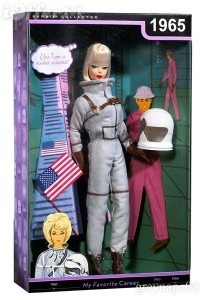 I have a new story out! “Please Look After This Angel” is the piece that was read in the marvellous theatrical performance at MONA the other week – now Island Magazine have put in online for you to read. Yes, you. It’s my first ever angel story (I THINK) which does not include clockwork. Keep an eye out for the others – I particularly enjoyed Michael Blake’s “Breathless” on the night, and thought that Melissa Howard’s “The Watchers” felt very Margo Lanaganesque – I will be interested to see how reading the stories on the page changes my opinions after experiencing them for the first time as a dramatic reading!
I have a new story out! “Please Look After This Angel” is the piece that was read in the marvellous theatrical performance at MONA the other week – now Island Magazine have put in online for you to read. Yes, you. It’s my first ever angel story (I THINK) which does not include clockwork. Keep an eye out for the others – I particularly enjoyed Michael Blake’s “Breathless” on the night, and thought that Melissa Howard’s “The Watchers” felt very Margo Lanaganesque – I will be interested to see how reading the stories on the page changes my opinions after experiencing them for the first time as a dramatic reading!
Also, my littlest daughter turned 3 yesterday which has come as a shock to all of us but did mean I could finally find an owner for the Astronaut Barbie I found on sale nearly a year ago. She also received a Cupcake Kitchen, a Wonder Woman board book, and an Alice in Wonderland costume. Love you, Jem!
But you’re not here for me talking about me, you’re here for linky links. Let us proceed!
The World Fantasy shortlist is out and how excited was I to see amazing Australian talent Kathleen Jennings on it as Best Artist? I WAS THIS EXCITED! Also lovely to see fellow Australian Lisa Hannett on there for her collection, and honorary Aussie Charles Tan up again for his excellent blog Bibliophile Stalker, which is one of my absolute internet staples. From a “favourite work of the year” standpoint I am especially glad to see Jo Walton’s Among Others, Karen Joy Fowler’s amazing “Younger Women” and Maureen McHugh’s After the Apocalypse in there, but there’s a whole bunch of excellent work being recognised. Hooray, must be awards season or something!
Gail Simone and her Secret Six artist Jim Calafiore are running a Kickstarter for their graphic novel Leaving Megalopolis which sounds amazing. It’s only a couple of days in and they’re already 2/3 at their goal, so it looks like it’s going to be one of THOSE Kickstarters.
A convention featuring Kelly Sue DeConnick (Captain Marvel!) and her husband Matt Fraction (writer of the best Iron Man I’ve ever read) made the error of putting Kelly’s marital status in the first line of her bio instead of, you know, all her actual comics writing cred. A bunch of comics writers & high geek gentlemen (yes, OK, Wil Wheaton) showed their support for Kelly through mockery of the mistake, adding “is not the wife of Matt Fraction” to their own bios and tweets across the internet. Meanwhile, Fraction himself declared himself Mr DeConnick on his own Twitter bio. It’s all been sorted out and apologised for now, but was funny at the time.
Speaking of apologies, Readercon made a good one this week.
Lest we forget what was actually at the heart of all this talking, fingerpointing and apologising, Justine Larbalestier writes powerfully about why women who are harassed often stay silent, and Farah Mendelsohn talks about how things have changed at conventions since the “good old days” and why things are better now, even though (especially because) we’re hearing about more problems. There’s some great discussion in the comments of that one.
Bluemilk points to what a transperson has to tell us about sexism in academia.
Moving over to the lighter side of feminist debate, Kate Beaton exposes the true horror of straw feminists. Careful, there might be one in your cupboard!
The ever awesome Mary Beard talks about enjoying the Olympics, but considering the physical ramifications of elite sports on the body, and whether our definition of “fit” is perhaps shortsighted.
Seanan Maguire talks about publicity efforts that have the effect of making you want to slam the metaphorical door in their metaphorical faces.
Jeff Vandermeer has some inspiring and sensible words of wisdom about publishing, and how a lot of the current rhetoric is actually pretty shortsighted.
Sarah Rees Brennan answers a question about book piracy, and with great class and restraint manages to articulate why her opinions on the topic are rather different to those of Neil Gaiman.
Considering she had people listing her work on piracy sites as an overt personal attack upon the publication of her first novel, it’s hardly surprising!
Damien Walter looks at why women have something to offer to the traditionally malebound hard SF genre. If you usually risk the comments, I highly recommend with this one that you don’t, if only to prevent head-sized dents in all your walls.
Terri’s crazy cupcake adventure continues with her explanation behind the gorgeous Nightsiders cupcakes. Scorched lemon meringue, mmmm. That’s one of the ones I DID manage to taste at Continuum.
Finally, you know Dan Stevens? As in, Matthew Crawley from Downton Abbey? He’s also a judge for the Booker this year, and I adore the sarcasm of the first paragraph of this column in which he takes the piss out of the constant use of the phrase ‘snubbed’ in responses to the longlist for the award. As judges for much more small scale literary awards this particular use of that particular word has always driven me completely up the wall, and now I know who to quote next time it happens to me. Good show, that chap in the top hat! (he does wear top hats in real life, right?)
Sadly not a great quality version but I am grateful SOMEONE finally put the 4th Super Best Friends Forever short up on YouTube. Damn it, is it going to be like 5 years before they have enough to justify a DVD?
August 8, 2012
Where the Wonder Women Are: #15 Jean Grey
 When the X-Men first began their (less than popular) run in 1963, the team only had one woman in it – and sure enough, she had ‘girl’ in her name. Jean Grey, AKA Marvel Girl, followed in the early comics superteam tradition of being the token female character whose powers were frankly lesser than all the men (or at least, they were written that way) and whose main character arc was to be the girlfriend/wife of one of her teammates.
When the X-Men first began their (less than popular) run in 1963, the team only had one woman in it – and sure enough, she had ‘girl’ in her name. Jean Grey, AKA Marvel Girl, followed in the early comics superteam tradition of being the token female character whose powers were frankly lesser than all the men (or at least, they were written that way) and whose main character arc was to be the girlfriend/wife of one of her teammates.
But like Wasp of the Avengers, and Invisible Girl/Woman of the Fantastic Four, Jean Grey’s character developed significantly over the years, and her powers expanded to match. In fact, the expansion of her power became a vital element of her character arc, culminating in her transformation away from her old Marvel Girl identity into Phoenix, then Dark Phoenix, and beyond.
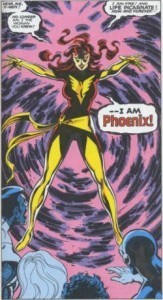 In the recent re-release of the epic Dark Phoenix story arc from 1980, writer Chris Claremont said that giving Jean the Phoenix powers in the first place was part of an attempt to release her from the legacy of being “a Stan Lee girl,” but neither he nor artist John Byrne foresaw quite where Jean’s expanding powers would take her – how high she would rise, or how far she would fall.
In the recent re-release of the epic Dark Phoenix story arc from 1980, writer Chris Claremont said that giving Jean the Phoenix powers in the first place was part of an attempt to release her from the legacy of being “a Stan Lee girl,” but neither he nor artist John Byrne foresaw quite where Jean’s expanding powers would take her – how high she would rise, or how far she would fall.
Because yeah, spoilers, Jean Grey dies. Actually, she dies a lot. The ‘phoenix’ name comes to be of great significance, as death and rebirth is a vital element of Jean’s storyline from 1980 all the way through to the present day. (She’s been dead for a while in the Marvel universe but guess what, she’s coming baaaack later this year)
I’ve always regarded Jean’s Dark Phoenix storyline with some skepticism, as it sounded very much like the trope we have in so many stories of a powerful women being punished, or indeed a woman being depicted as unable to handle great power. It wasn’t helped that this was a central element of the widely-panned third X-Men movie – while I objected far less at the time to Jean’s sacrifice than I did to Rogue giving up her power willingly, or the idea that young Jean had to be “protected” from her own power by Professor X, it’s hard to deny that her death is in fact entirely there to serve Wolverine’s character arc and not her own.
But on reading the original Dark Phoenix issues in the trade, I was actually impressed at how well it was written, and how much this was Jean’s own story. There’s a big difference between a female character who sacrifices herself as part of her own narrative, and one who does so to serve the narratives of the men around her.
I missed the original death and return of Jean Grey and the Phoenix storyline, but read with great interest the development of Dark Phoenix – while later there is much development of the idea that the ‘phoenix force’ is a parasitic entity, here it is very much an identity that comes from Jean and could be looked at as an exploration of mental illness.
I was a little irritated that the people around Jean, especially her close friend Storm and her earnest but dull boyfriend Scott/Cyclops, kept banging on about what a worry it was that Jean was so powerful now that she was Phoenix. Sure, she suddenly had massively increased powers, but this was obviously an attempt to telegraph the coming plot rather than based on any idea that Jean was bad at handling power.
 Actually Jean was handling the extra Phoenix power just fine, but unfortunately had become a tasty target because of it. A villain called Mastermind took on the alarmingly moustached persona Jason Wyndgarde (why yes he did look exactly like actor Peter Wyndgarde who played TV character Jason King) and set about using telepathic technology (borrowed from Emma Frost) to unsettle Jean’s sense of time, place and identity through historical flashbacks and some heavy breathing romance.
Actually Jean was handling the extra Phoenix power just fine, but unfortunately had become a tasty target because of it. A villain called Mastermind took on the alarmingly moustached persona Jason Wyndgarde (why yes he did look exactly like actor Peter Wyndgarde who played TV character Jason King) and set about using telepathic technology (borrowed from Emma Frost) to unsettle Jean’s sense of time, place and identity through historical flashbacks and some heavy breathing romance.
Through these visions, he convinced Jean of her past life as his bride and the ‘Black Queen’ of The Hellfire Club, and slowly manipulated her into accepting that identity and turning against her friends the X-Men. While at first this appeared to be an excuse to lead the X-Men’s sweetest “good girl” down a path of saucy debauchery and dominatrix action, it was actually a far more serious story. The X-Men and Cyclops in particular were unwilling to release Jean to this weird, kinky mob, and the situation led to a massive showdown on the physical as well as mental plane. Cyclops sacrificed himself (nice when boys do this too) to shock Jean into remembering who she was. Luckily deaths on the mental plane apparently don’t count, Cyclops was fine, and Jean succeeded in breaking her conditioning and regain her real identity…
 But Jean was angry at how she had been used. She turned her power on Jason/Mastermind and tortured him by opening his mind up to the universe. Though she concealed the extent of what she had done from her friends, it was very much this action of revenge that broke Jean, and opened her up to her Dark Phoenix identity. Swallowed up by what appeared to be a total and sudden psychotic breakdown and flooded by godly powers, she attacked her friends and went on a destructive grand tour of the universe. Among other things, she casually consumed the energy of an entire star (which had the unfortunate side effect of killing the billions of aliens who lived in the worlds nearby) and destroyed an alien ship attempting to stop her rampage.
But Jean was angry at how she had been used. She turned her power on Jason/Mastermind and tortured him by opening his mind up to the universe. Though she concealed the extent of what she had done from her friends, it was very much this action of revenge that broke Jean, and opened her up to her Dark Phoenix identity. Swallowed up by what appeared to be a total and sudden psychotic breakdown and flooded by godly powers, she attacked her friends and went on a destructive grand tour of the universe. Among other things, she casually consumed the energy of an entire star (which had the unfortunate side effect of killing the billions of aliens who lived in the worlds nearby) and destroyed an alien ship attempting to stop her rampage.
Finally sated, Jean returned to her childhood home and tried to connect to whom she had been before. The X-Men were able finally to subdue her, and through a psychic battle with her mentor Professor X, Dark Phoenix was conquered and Jean Grey became herself again, completely under control.
The story could have ended there, but a bunch of galactic forces promptly turned up to take Jean into custody. They were understandably miffed about the genocide of billions, and not inclined to accept the testimony of the X-Men that she was fine now, and it was all cool. The ethical issues were discussed at length by Jean and her closest friends in between a duel to the death. Sadly, the stress of the situation broke the psychic barriers once more and let Phoenix out to play.
 Jean’s sacrifice of her life was a conscious choice on her part, not only because she had become aware of how dangerous and uncontrolled she was as Phoenix, but also because she felt there was no other way to atone for the awful crime she had committed. There is a quite touching moment where she takes on her Marvel Girl costume once again for her final battle, accepting her entire history. And she dies, leaving her friends miserable and Cyclops distraught. Don’t be too sad for him; he’ll get used to this.
Jean’s sacrifice of her life was a conscious choice on her part, not only because she had become aware of how dangerous and uncontrolled she was as Phoenix, but also because she felt there was no other way to atone for the awful crime she had committed. There is a quite touching moment where she takes on her Marvel Girl costume once again for her final battle, accepting her entire history. And she dies, leaving her friends miserable and Cyclops distraught. Don’t be too sad for him; he’ll get used to this.
The death of Jean Grey was an editorial mandate. Original writer Chris Claremont and artist John Byrne wanted the story to be one of redemption, but the casual destruction of billions was seen as something that could not be ignored, and so they were given two choices – let her count as a villain from now on, or kill her off. The plan being of course that, while superhero deaths were never ever permanent, this one would be.
Except for the part that… well. You know what phoenixes do, right?
Whether alive or dead, returning or “gone for good,” Jean Grey has continued to be vital and iconic part of the X-Men story. Likewise the Phoenix Force, now portrayed as a separate creature and one which can be ‘hosted’ by others, is an essential part of their history and legacy.
In the 90’s, during one of her returns, she began to be identified purely by her name, Jean Grey, because ‘Phoenix’ had come to have specific connotations, and she had long outgrown ‘Marvel Girl.’ This was the case in other media, not just the comics themselves, and is a rare case of a human superhero whose real name is better known than any codename or alternative identity.
 In the various animated series that have reinvented and rebooted the X-Men for several new generations, Cyclops and Jean are always there as the sweet if slightly dull couple who serve as responsible role models at the core their team, the Head Boy and Head Girl of Professor Xavier’s school, and the perfect examples of his students. And, inevitably, their sweetness and normality doesn’t quite last – cracks start showing, either in their relationship or through the appearance of the Phoenix plot, to mess everything up for them.
In the various animated series that have reinvented and rebooted the X-Men for several new generations, Cyclops and Jean are always there as the sweet if slightly dull couple who serve as responsible role models at the core their team, the Head Boy and Head Girl of Professor Xavier’s school, and the perfect examples of his students. And, inevitably, their sweetness and normality doesn’t quite last – cracks start showing, either in their relationship or through the appearance of the Phoenix plot, to mess everything up for them.
Meanwhile, in the comics, Scott and Jean have had children in alternate timelines, have been married and broken up, have lived in the future, and have both been at least partly unfaithful thanks to the sexy temptations offered by Wolverine, Psylocke and Emma Frost (a rival telepath who began as the White Queen of the same Hellfire Club that messed Jean up in the first place). For a long time now, Jean has been dead all over again, while Cyclops moves on romantically with Emma, the two of them running Professor X’s school together.
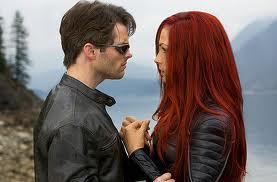 ‘My’ Jean Grey was the heroine of the 90’s TV series of X-Men, of course, though I also liked her a lot in X-Men Evolution (in which she is literally the Head Girl as well as a soccer player and all around stern good girl) and in the movies, as played by Famke Janssen. The movie version is notable because she is portrayed as a mature, educated woman (and a medical doctor) rather than starting her yet again as a teenager. [In the comics she has managed to acquire a degree in psychology and even attained her Masters, which is quite impressive for someone who has to spend a significant portion of every decade dead] Of course, it all goes to hell in the third movie, but the first two and the second film in particular provided some wonderful character moments for Jean and for the men in her life.
‘My’ Jean Grey was the heroine of the 90’s TV series of X-Men, of course, though I also liked her a lot in X-Men Evolution (in which she is literally the Head Girl as well as a soccer player and all around stern good girl) and in the movies, as played by Famke Janssen. The movie version is notable because she is portrayed as a mature, educated woman (and a medical doctor) rather than starting her yet again as a teenager. [In the comics she has managed to acquire a degree in psychology and even attained her Masters, which is quite impressive for someone who has to spend a significant portion of every decade dead] Of course, it all goes to hell in the third movie, but the first two and the second film in particular provided some wonderful character moments for Jean and for the men in her life.
I was less impressed by the otherwise excellent Wolverine & the X-Men animated series which generally portrayed Jean as an object rather than a protagonist, and I really disliked the portrayal of Jean as a quirky magical punk pixie girl in the Ultimate X-Men comics, because I didn’t buy her as the character.
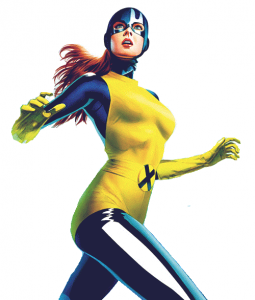 I recently read Jean’s ‘origin’ story in the X-Men Origins series of trades. Origin stories drawn and written decades after the actual origin can be quite patchy, but this one written by Sean McKeever had its moments. I particularly liked the scene in which Jean uses her telekinetic powers to prevent a catastrophe and proudly declared that she was a normal teenage girl. Again, Jean’s relationship to her developing mental powers were depicted as if she was dealing with a mental/brain chemical disorder, and in this case it was done so with reasonable sensitivity if a bit too heavy on the angst. But frankly any reference at all to the way Professor X wormed himself inside her brain tends towards the creepy, even if her parents gave permission, especially as the old comics used to have Professor X secretly crushing on Jean. Ew, inappropriate!
I recently read Jean’s ‘origin’ story in the X-Men Origins series of trades. Origin stories drawn and written decades after the actual origin can be quite patchy, but this one written by Sean McKeever had its moments. I particularly liked the scene in which Jean uses her telekinetic powers to prevent a catastrophe and proudly declared that she was a normal teenage girl. Again, Jean’s relationship to her developing mental powers were depicted as if she was dealing with a mental/brain chemical disorder, and in this case it was done so with reasonable sensitivity if a bit too heavy on the angst. But frankly any reference at all to the way Professor X wormed himself inside her brain tends towards the creepy, even if her parents gave permission, especially as the old comics used to have Professor X secretly crushing on Jean. Ew, inappropriate!
Jean Grey is coming back. Which is interesting, because Jean Grey not coming back has been a major emphasis of the last decade of X-Men comics – in Joss Whedon and John Cassaday’s run of Astonishing X-Men for example, he teased out the idea that Jean might return, and that the characters are all half waiting for her to do so, but pulled a whammy by resurrecting a completely different classic character instead.
In this case, it has been announced that Jean upcoming return will not be another resurrection, but part of a timeslip comic in which the original 1963 X-Men team appear in the present day, and have to deal with the discovery of what their future selves have been getting up to.
Part of me hopes that She-Hulk turns up at some point to lead them to the archive of Marvel Comics Continuity because, seriously. Surely the first question they’re going to ask is “why has no one aged significantly in the last forty years?” and maybe “Explain Twitter.”
 So it’s not just Jean Grey making her return, it’s Marvel Girl, 60′s style. While I do get irritated by the regular youthening of female superheroes, in this case I think the concept is pretty exciting, especially as Jean is bringing her own straitlaced, earnest and baby-faced version of Cyclops along for the ride.
So it’s not just Jean Grey making her return, it’s Marvel Girl, 60′s style. While I do get irritated by the regular youthening of female superheroes, in this case I think the concept is pretty exciting, especially as Jean is bringing her own straitlaced, earnest and baby-faced version of Cyclops along for the ride.
Stripped of the Marvel Girl or Phoenix identities, and regardless of some bizarrely varied costume changes over the years, Jean Grey remains an iconic and central character in the Marvel universe. Her powers are often depicted as second only to those of Professor X, with the possibility that she could eclipse him always there. Whether she is destroying galaxies, catching trains in mid-crash or psychically altering the minds of her fellow humans, Jean Grey’s powers and her storylines raise fascinating issues to do with superpowers, ethics and responsibility.
I don’t think her story is done. If I could wish one thing, it would be that the returning Jean Grey be given massive stories that don’t always rely on her relationships with Cyclops, Wolverine or Professor X, but with some of her fellow super heroines and particularly with her time-displaced daughter Rachel Summers, who has her own Phoenix issues.
But mostly, now that I know so much more about both characters, I want to see her and Emma Frost trapped in an elevator together until they can talk out their issues.
If you want to read some great essays about Jean Grey and Emma Frost (as well as Kitty Pryde and many others) by readers who are far more experienced and well-read about those characters than I am, go grab a copy of Chicks Dig Comics. It’s a great book all around, but I was particularly inspired to learn more about those three Marvel women thanks to the enthusiastic and powerful essays about them.
Where the Wonder Women Are:
0: Introduction
1: Black Canary
2: Rogue
3: Hawkgirl/Hawkwoman
4: Black Widow
5: Wonder Girl
6: Captain Marvel
7: Vixen
8: Abigail Brand.
9. Jubilee
10. Batwoman
11. Catwoman
12. Huntress
13. Robin
14. Batgirl
August 7, 2012
Good Sports, Bad Sports
Australian rowers Kim Crow and Brooke Pratley – winning silver is not losing.
Australia won two gold medals last night, which is lovely, especially for champion cyclist Anna Mears and champion hurdler Sally Pearson, who actually won the medals in question, and are both understandably elated.But I’ve been far more interested in how Australians have reacted to NOT winning the expected number of gold medals over the last week and a half. This is the first time I’ve watched an Olympics with an animated, interested primary age child (in some cases, thanks to hanging out with friends, several children) who is capable of understanding a good deal of what’s going on, and it has made a huge impact on how angry I have got about the coverage.
I’ve come to the conclusion that the Australian media, and Channel Nine in particular, have been providing a very bad example to our kids. It feels like every day I’m getting angry, about sexist reporting, about the lack of coverage of the achievements of other countries (my daughter has repeatedly asked why she hasn’t yet seen a medal ceremony where someone else’s national anthem is played), and particularly in the way that reporters have repeatedly belittled the huge number of silver and bronze medals that Australians have received.
You know, silver and bronze medals which mean they are absolute elite sportspeople at the top of their professions? Since when is being second fastest or second highest scoring something to be equated with coming LAST? Even those who come last are coming last among the top 8 or 12 in their field. It’s still pretty bloody good!
I know that it’s hard when your expectations are crazy big and you fall short of what you thought you were going to get. But even those expectations were loaded so heavily with gender issues and parochialism. Did, for example, the Australians really think that Great Britain were not pouring all their resources into a great showing at these games?
But the national bafflement, especially as reflected in the news and sports reporting of this event (not just Channel Nine, though I’ve been exposed to more of their silliness than anyone else’s) is not just irritating, but damaging. I personally don’t think that our lack of gold medals should require a national enquiry or worst of all, that it should become the next big election issue. We weathered the global financial crisis better than a whole bunch of other western countries and I don’t think throwing money at the issue is remotely appropriate.
Maybe Australia should just learn to be classy in defeat.
Once kids start playing sport at school, especially the very young children (my daughter plays under 7′s soccer) we work so hard to make sure they are taking in the important messages of sport – about trying your best, and learning to work with a team, and building up skills. But most of all, we try to teach them good sportsmanship. How to win with grace, and deal with a loss through good humour and a sense of perspective. Being kind and generous to your opponents, and behaving well. Taking positives out of games, regardless of the score, because it’s all about improving.
Sometimes it doesn’t work out that way. Our kids have to deal with sledging, or over-competitive coaches, or rough behaviour on the pitch. Sometimes it’s coming from other teams, sometimes even from within. We as parents have to learn how to encourage and celebrate our children without being THOSE parents who put too much pressure on them, or embarrass them through getting overly angry-frustrated over a game.
So seeing extended interviews in which a male rowing team are given license to complain bitterly and sadly (at extraordinary length) about coming second in a world competition, or hearing reporters ask athletes how disappointed they are, or how devastated they are, when they have won FREAKING silver or bronze medals, has been deeply disappointing. Luckily I’m here to point out this ridiculousness to my daughter, but Channel Nine, when you punch the air with excitement at the gold medal achievements of our athletes, and crow about how inspiring this is to the younger generation, it’s kind of important to remember that those kids were also watching you before, through the whingeing and the self-pity and the belittling of other achievements.
This morning I explained to Raeli about Cyprus, who came second in the race where the Aussie bloke won a gold medal for sailing, and how it’s their country’s first ever Olympic medal, and how it means more to them than anything. They don’t think silver is second best, or that it’s a minor achievement. I’d love to see the Olympics celebrate more stories like that – if it’s about celebrating excellence and sportsmanship then how about showing us some of the other countries and their achievements?
I’ve been pleased to see many athletes explaining that gold medals aren’t necessarily the point of the meet – about the importance of trying to beat your own personal best, or to make the medal tally at all, let alone to make it to a final which is in itself an extraordinary achievement. Sometimes emotion does take over, when you fall short of your own expectations. Disappointment is inevitable. But plenty of our bronze and silver medallists are rightfully delighted at their achievements! It’s hard to miss that tor every enormous Aussie grin at receiving bronze or silver, acknowledging that another athlete or team was better on the day, or showing good sportsmanship, there have been reporters trying to turn the story into another one of failure, of loss, and of misery, because the shiny trinket is the “wrong” colour.
Winning silver is winning silver. It is not the same as “losing.”
Gold is exciting and wonderful, sure. But it has been depressing to see that the Australian media is so lacking in imagination that it can’t celebrate our actual achievements rather than perceived failures, and that it can’t properly celebrate the greater achievements of other countries and cultures.
My favourite thing about Sally Pearson’s win was not just her complete joy at her achievement, but the joy shown by her closest rivals in her success as well as her own. And yes, the Channel Nine reporters did point this out, delighted at such an example of good sportsmanship. But it would be nice if they had been quite as keen to point out how good sports behave back when we weren’t winning gold.
Be classy, Australia. The kids are watching. Say it with me: it’s an honour just to be nominated.
Now try to mean it.
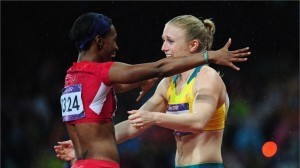
Kellie Wells of the USA hugs gold-medal winner Sally Pearson after the the women’s 100m Hurdles final
August 6, 2012
Motherhood: the Ultimate Writing Accessory?
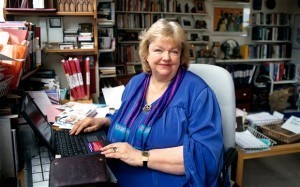 The Frisky pointed to an article in the Telegraph by Amanda Craig about Maeve Binchy’s career, and the difference between women writers who are mothers and those who are not.
The Frisky pointed to an article in the Telegraph by Amanda Craig about Maeve Binchy’s career, and the difference between women writers who are mothers and those who are not.
At first, coming in on a wave of The Frisky’s outrage, I thought it wasn’t as bad as I had expected. After all, it did acknowledge a whole bunch of pros and cons for juggling writing and motherhood, and seemed to be balanced. But the more I read, the less balanced it seemed. Because it’s not as it turns out an article about how women are screwed no matter what they do (though that is the ultimate message). It’s an article about how women writers who are also mothers are simultaneously a suffering underclass, and a tribe representing superiority.
How about this:
“No matter what your experience of adult love, there is nothing as strong as the bond between a mother and a child. One reason why so many contemporary women writers have focused on this is that it is new territory, precisely because the great female writers of the past had not experienced it.”
So much wrong with this. Never mind the exclusion of the male parenting experience, or the ridiculous romanticisation of mother love, but I’m sorry, are you really saying that NO great women writers of the past were mothers, or wrote about motherhood? It’s not that novels by mothers about children were automatically considered ‘slight’ or ‘domestic’ and ignored by academics or anything?
It’s hard being a mother and a writer. I know this fact quite intimately. (It doesn’t make me a better writer any more than having one arm in a plaster cast while typing would make me a better writer, though it does make me a more tired writer) But I also know that in a hundred different ways, it’s easier now to be a mother and a writer than it ever was in the past.
That doesn’t mean that all women writers are obliged to represent motherhood. No one would actually think that was an acceptable thing to say in this day and age, would they?
What I took from that article is – women can’t win. Women writers who are not mothers are going to be pointed to because of their ‘childless state,’ and maybe taken less seriously because of that, but women writers who are mothers are going to have to fight AS WELL to be taken seriously in both spheres. The same is true for any working mothers, actually, lest we forget the continuing use of the term ‘mommybloggers,’ or the way that the Australian prime minister is constantly harangued by the media and the public for not having children that they can complain she is neglecting. (so selfish of her, they could have filled so many pages whingeing about those imaginary neglected children!)
This article, to my mind, isn’t just suggesting that Maeve Binchy’s writing was somehow missing something because she hadn’t had the experience of squeezing a baby out of her vagina and keeping it alive for the next eighteen years, but is ALSO suggesting that women who don’t have children but write novels somehow have an unfair advantage over those who do both. As if they are cheating at life.
Maeve Binchy was an awesome, intelligent lady who wrote hugely successful books and was beloved by her whole community as well as her friends and family. She had a long and rich life and gave so much joy to so many people. Why on earth would anyone think it was appropriate to write now about how she didn’t “have it all”?
“Yet putting yourself last is one of the best things that can happen to a writer. I make no moral claims for motherhood — which can bring out the worst in a person, in the form of vicarious rivalry, bitchiness, envy and even mental illness — but going through the ring of fire does change you and bring about a deeper understanding of human nature. ”
Um, so does experiencing front line combat, or climbing a mountain, or surviving a devastating bushfire, or running a marathon, or I don’t know, achieving your life’s desire to write and publish excellent novels. But it’s amazing how many people don’t have their lack of those experiences discussed at great length. We don’t talk about how Jane Austen never shot and skinned her own deer, or George Eliot was crap at whitewater rafting, or the Brontes never drove a Mini Cooper.
Seriously, they never ONCE drove a Mini Cooper. How can we claim their books are good when they never experienced everything that humanity has to offer?
The idea that Maeve Binchy might have written deeper, more enlightening novels, had she experienced motherhood, is patronising and awful. The idea that maybe she wrote about the WRONG THING because her books weren’t about parenting is bizarre and offensive. You would never hear anyone say either of those things about a man. But you can bet that had Binchy been a mother, that motherhood would have at some point been used as a stick to beat her, either for not being a good enough writer or not being a good enough mother or, as with Enid Blyton or any number of other women, both.
We’ve had hundreds of years of women’s writing being dismissed for being too domestic, and the most interesting thing Amanda Craig can think of to write about a writer like Binchy is that she wasn’t domestic enough?
That’s pretty bloody shameful.
Check out these obituaries of Maeve Binchy, which talk about her rich life, wonderful personality, and how much she was loved by her family and friends. The life she had, and the laughter she inspired. This is how she should be remembered.
Oh and if you are female, Karen Healey wants you to tell her why you’re awesome. Hopefully you’ll find that thread as inspiring as I did, and a necessary antidote to the ridiculousness at the Telegraph.
August 3, 2012
Where the Wonder Women Are: #14 Batgirl
Batgirl is one of my absolute favourites, in all her variations. As with many other legacy characters, emotions often run high between fans as to which Batgirl is the best, but I think it’s important to celebrate all of them, and the legacy that each character has brought to the name.
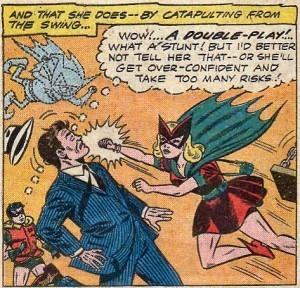 As I mentioned back in the Batwoman post, the first Bat-Girl was actually the blonde and bubbly Betty Kane, sidekick to her elder cousin Bat-Woman and occasional girlfriend to Robin.
As I mentioned back in the Batwoman post, the first Bat-Girl was actually the blonde and bubbly Betty Kane, sidekick to her elder cousin Bat-Woman and occasional girlfriend to Robin.
These characters mostly existed to make Batman and Robin appear less gay, and as with most women in 1950’s comics, the Comics Code which laid out the expectations for female characters in comics ensured that Bat-Girl and Bat-Woman were portrayed as hyper-feminine ditzes, more worried about whether or not the boys liked them than whether the criminals had escaped or not. When they did show actual crimefighting chops, the boys were quick to patronise them so they wouldn’t get ideas above their station.
Betty Kane appeared only seven time over four years, and was written out altogether when it was decided that the Bat-Family made Batman himself appear lightweight. (Betty was later restored to the DC Universe as Bette Kane AKA Flamebird, and joined Batwoman once again as her sidekick)
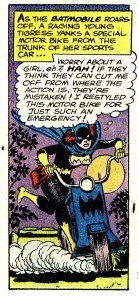 Only a couple of years after Betty disappeared, a new Batgirl was written into Gotham City: red-haired Barbara Gordon, daughter of Commissioner James Gordon (a supporting character who had been part of the Batman comic since its launch in 1939).
Only a couple of years after Betty disappeared, a new Batgirl was written into Gotham City: red-haired Barbara Gordon, daughter of Commissioner James Gordon (a supporting character who had been part of the Batman comic since its launch in 1939).
A librarian with a PhD, Barbara makes her own “Batgirl” costume for a fancy dress party, and then finds herself mistaken for a real life superhero. After foiling some crooks almost by accident, she decides that she rather likes doing that sort of thing, despite Batman’s initial disapproval. Allowed to be far more pro-active than her predecessors now that the Swinging Sixties were leaving the Comics Code in the dust, the “Darknight Damsel” rode a motorcycle, displayed martial arts skills, and used all manner of fun tools and weapons just like Batman himself.
Barbara Gordon’s Batgirl was created to be a character who could also be used in the live action TV series, then about to head into its third season, to draw in female viewers. Played by Yvonne Craig in the TV series, she was popular enough that it was even suggested she should have her own show. Yvonne Craig’s Batgirl was even used to promote the important political issue of Equal Pay in an official PSA.
The fact that the original Batman TV series is not available on DVD is a crime against humanity. I’m just saying.
Batgirl, the Dominoed Daredoll (yes, really) continued to be an important member of the supporting cast of the Batman comics of the 60’s and 70’s – and Barbara’s character was allowed to develop in quite interesting ways.
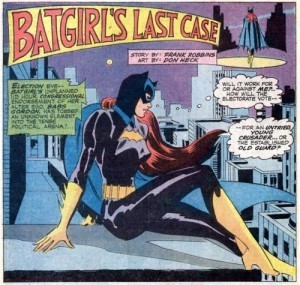 Frustrated with what she saw as the limited usefulness of their roles as costumed vigilantes, Barbara’s opinions about law enforcement and the flaws in the prison system led her to campaign for Congress and to move to Washington. At this point she officially retired as Batgirl (and confessed her secret to her father, who had already guessed it) but later found a use for her Batgirl identity again and had many adventures in Batman and Superman comics, often teaming up with Supergirl.
Frustrated with what she saw as the limited usefulness of their roles as costumed vigilantes, Barbara’s opinions about law enforcement and the flaws in the prison system led her to campaign for Congress and to move to Washington. At this point she officially retired as Batgirl (and confessed her secret to her father, who had already guessed it) but later found a use for her Batgirl identity again and had many adventures in Batman and Superman comics, often teaming up with Supergirl.
For three years, Batgirl was even the lead character of her own comic, titled Batman Family. There are some rather adorable stories from this era in which Dick Grayson is working as an intern for Barbara in Washington, and they both fight crime as Robin and Batgirl at night, but are yet to figure out each other’s secret identities.
 There are occasional hints of romance between Robin and Batgirl in this era – and indeed, between Dick and Babs – but these are often downplayed in that discreet black and white comics way, with their friendship emphasised over a real love story. It’s notable that there is never any hint of romance between Batman and Batgirl (or indeed, between Batman any of the Batgirls). Barbara did, however, once go on a date with Clark Kent, and forged a friendship with him independent of her relationship with Batman.
There are occasional hints of romance between Robin and Batgirl in this era – and indeed, between Dick and Babs – but these are often downplayed in that discreet black and white comics way, with their friendship emphasised over a real love story. It’s notable that there is never any hint of romance between Batman and Batgirl (or indeed, between Batman any of the Batgirls). Barbara did, however, once go on a date with Clark Kent, and forged a friendship with him independent of her relationship with Batman.
Batgirl did not participate greatly in the Crisis of Infinite Earths event of 1985, though she did read the eulogy of her friend Supergirl, who was killed in battle. The massive reboot that followed, however, changed her character quite drastically.
This post-Crisis Batgirl never knew Supergirl, who was retroactively erased from existence. Some of their past adventures were retold as if they had happened to Batgirl and Power Girl, but the friendship was not portrayed with a similar level of closeness. Also, Barbara was no longer Commissioner Gordon’s biological daughter, but his niece and adopted daughter. Her revised origin focused on her athletic abilities and martial arts training, and less on her life as a highly qualified librarian. Her political career was erased.
 In 1988, in a Batgirl Special, Barbara officially retired (again) from being a costumed crusader. Later that same year, she was shot in her civilian identity by the Joker in The Killing Joke, in order to punish her father. Famously, when the writer Alan Moore checked with the office if it was okay for him to declare that Barbara would be permanently paralysed, the editor discussed it with the Executive Editorial Director and then came back on the phone to say: “Yeah, okay, cripple the bitch.”
In 1988, in a Batgirl Special, Barbara officially retired (again) from being a costumed crusader. Later that same year, she was shot in her civilian identity by the Joker in The Killing Joke, in order to punish her father. Famously, when the writer Alan Moore checked with the office if it was okay for him to declare that Barbara would be permanently paralysed, the editor discussed it with the Executive Editorial Director and then came back on the phone to say: “Yeah, okay, cripple the bitch.”
The fate of Barbara Gordon was later discussed and analysed at length as a key example of “Women in Refrigerators,” the phenomenon of female characters in comics repeatedly being sacrificed to move forward the plot or emotional journey of male characters. I doubt I’m remotely doing the topic justice.
It could have ended there, but writer Kim Yale was quite furious at the treatment of the iconic character of Barbara Gordon. Together, she and her husband John Ostrander, both working for DC, developed the character of Oracle, a mysterious figure who used advanced computer systems to assist superheroes in the field. After several appearances over various titles, Oracle was revealed in 1990 to be Barbara Gordon, now wheelchair-enabled and kicking information technology arse.
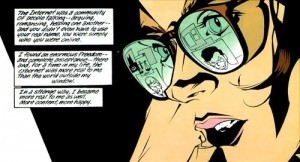 [And yes, I will be doing a separate post on Oracle at some point, as a wonder woman of comics in her own right. But for now I want to concentrate on the relationship Barbara continued to have with the Batgirl legacy.]
[And yes, I will be doing a separate post on Oracle at some point, as a wonder woman of comics in her own right. But for now I want to concentrate on the relationship Barbara continued to have with the Batgirl legacy.]
While Oracle formed an important partnership with Black Canary, her first field agent, and had her own regular comic Birds of Prey from 1996 onwards, she remained closely connected to Gotham City, and ended up playing “eyes and ears” to a variety of superheroes, many of them women. She set up home in the Clock Tower, a monument in Gotham.
In No Man’s Land, a major Batman event of the late 90’s, Gotham City was all but destroyed in an earthquake, then declared a no go zone by the American government, which went so far as to blow up the bridges leading to the city. With Bruce Wayne stuck outside the city, trying to use his wealth and political influence to save Gotham, there was no Batman inside to prevent the remaining people in the city from falling into violent gang warfare and the dissolution of civilisation.
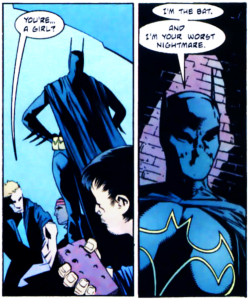 Barbara found herself secure but trapped in her Clock Tower, unable to travel far from home thanks to rubble in the streets, and frustrated by the lack of power in the city which meant she was also cut off from most of Oracle’s usual information sources (she had electricity and phone lines for instance but most of the villains didn’t, so she couldn’t listen in on them!). Feeling abandoned by Batman, Barbara was especially furious to discover that a woman in a Batsuit was patrolling the city. Assuming that whoever it was had Bruce Wayne’s approval, she was gutted that he should have nominated a replacement for Batgirl, whom she still thought of as her own.
Barbara found herself secure but trapped in her Clock Tower, unable to travel far from home thanks to rubble in the streets, and frustrated by the lack of power in the city which meant she was also cut off from most of Oracle’s usual information sources (she had electricity and phone lines for instance but most of the villains didn’t, so she couldn’t listen in on them!). Feeling abandoned by Batman, Barbara was especially furious to discover that a woman in a Batsuit was patrolling the city. Assuming that whoever it was had Bruce Wayne’s approval, she was gutted that he should have nominated a replacement for Batgirl, whom she still thought of as her own.
As it turned out, Batman had not endorsed the mystery woman’s use of the Bat symbol ahead of time, though he finally returned he did agree she should continue wearing the costume… briefly.
During a particularly bloody street battle, however, “Batgirl” (she never claimed that she was working under that name and indeed the only person who does use it to refer to her is Oracle in her internal narrative) was unable to stop Two-Face and his unexpectedly large army from killing a dozen of the “Blue Boys” (former police officers, now members of their own gang). Batman used this failure as an excuse to humiliate her, revealing that he had always known her identity (Helena Bertinelli, the Huntress). He proceeded to bully her mercilessly in front of Nightwing, declaring that she was too emotional to be trusted. Unsurprisingly, Helena handed over the Batgirl costume and stormed away, going rogue again – exactly as Batman had planned. Because he is an arse.
 Meanwhile, Barbara had found her own replacement, Cassandra Cain. This Eurasian teenager (whose name was obviously a play on the original Kathy Kane) was the daughter of super assassin David Cain, one of the men who had trained Bruce Wayne. Conditioned from young childhood to be the perfect assassin, she had also been raised without verbal or writing skills, so that she should be able to concentrate more fully on reading the visual cues of body language.
Meanwhile, Barbara had found her own replacement, Cassandra Cain. This Eurasian teenager (whose name was obviously a play on the original Kathy Kane) was the daughter of super assassin David Cain, one of the men who had trained Bruce Wayne. Conditioned from young childhood to be the perfect assassin, she had also been raised without verbal or writing skills, so that she should be able to concentrate more fully on reading the visual cues of body language.
Tormented by her own past and the murder she had been forced to commit, Cassandra started out as one of Oracle’s field operatives, and proved her worth by saving Commissioner Gordon from assassination by her father. Supported and endorsed by both Barbara and Batman, Cass took on the mantle of Batgirl and joined the Batman family.
Her Batgirl costume, the one taken from Helena, is a black leather catsuit with a full mask and symbolic stitches around her mouthpiece. Instead of the bright yellow logo once worn by Barbara, this Batgirl’s bat symbol is merely a yellow outline against the black.
 In 1999, Cassandra Cain became the first Batgirl to have an ongoing comic with that title. Her brain was adjusted by a telepath to gain verbal and writing skills, but she then had to start almost from scratch with martial arts training and body language perception, to get back what she had lost. She gave herself over to Lady Shiva, an infamous and dangerous assassin, for a year’s training with the promise of a duel to the death when that year was over.
In 1999, Cassandra Cain became the first Batgirl to have an ongoing comic with that title. Her brain was adjusted by a telepath to gain verbal and writing skills, but she then had to start almost from scratch with martial arts training and body language perception, to get back what she had lost. She gave herself over to Lady Shiva, an infamous and dangerous assassin, for a year’s training with the promise of a duel to the death when that year was over.
As well as Oracle and Batman, Cassandra had ties to many of the members of the “Bat Family,” especially Stephanie Brown (Spoiler/Robin) and Tim Drake (Robin/Red Robin). A later storyline had Cassandra discovering that Lady Shiva is her mother, stating that one of the reasons Lady Shiva chose to have a baby was to stop herself murdering people, though it didn’t work out that way. Cassandra defeats Lady Shiva more than once (the only person ever to do so) but always holds herself back from killing her, even when she is convinced it is the most moral choice she could make.
Dealing with the violence in her past and her nature is an important part of Cassandra Cain’s ongoing character arc. She was often shows struggling with these issues, going back and forth as to whether she was deserving of the name of Batgirl. After the time jump of the One Year Later storyline, Cass was revealed to have become the leader of the League of Assassins. It was later shown that she followed this path after being abandoned by Batman, Robin and Nightwing (who were away for a year-long trip – what, Batman was a thoughtless arse? You surprise me.) and manipulated by both Deathstroke and her father with the help of some mind-altering drugs.
The portrayal of Cassandra Cain as a sudden villain and antagonist was met with widespread dismay by her fans, many of whom were the same readers who had been so distressed by the way Stephanie Brown was tortured and killed a few years earlier. The unpopular move was gradually altered so that Cassandra was allowed to be heroic again, but was never explained fully enough for fans to accept or understand.
Despite Cassandra’s move to the dark side, Batman himself did not lose faith in her, and after she finally gained closure with her evil father in a deadly rooftop battle, Bruce decided to adopt her as a daughter.
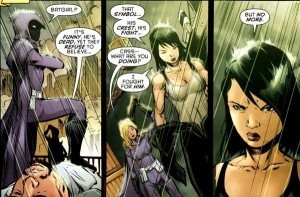 Then Batman died. Apparently disillusioned after the loss of her adopted father and mentor, Cassandra passed the Batgirl mantle to Stephanie Brown, her friend who had recently turned out to be less dead than previously supposed. (for the early history of Steph as Spoiler and then Robin, read this one)
Then Batman died. Apparently disillusioned after the loss of her adopted father and mentor, Cassandra passed the Batgirl mantle to Stephanie Brown, her friend who had recently turned out to be less dead than previously supposed. (for the early history of Steph as Spoiler and then Robin, read this one)
In fact, Cassandra was following Bruce’s standing orders. She went undercover as an operative for Batman while he was “dead” (he got better, of course) and later turned up in Hong Kong, representing Batman Inc under the (pleasingly gender-neutral) name Black Bat.
Meanwhile, there was a new Batgirl in town.
While many of Cass Cain’s fans were grieved to lose “their” Batgirl, Stephanie proved a popular and successful version of the character, with her own monthly title. As Spoiler she had overcome her villainous father’s wicked schemes, and as Robin she had faked her own death after managing to get every criminal in Gotham’s underworld out to get her. Now she was a college student, her junkie mother had got her act together and was working full time as a nurse, and things were looking a whole lot brighter.
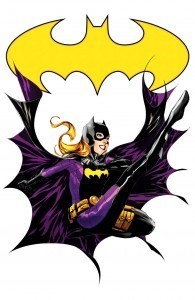 Written by Brian K Vaughn, the Stephanie Brown run as Batgirl was highly acclaimed, and still stands as an example of the great things you can do with a young female superhero. Steph juggled school, family and friends, and still managed to fight crime in a world without Bruce Wayne as Batman without losing her sense of humour. With Oracle and the new Batman (former Nightwing Dick Grayson) as her mentors, and the bratty Damien Wayne as the occasional thorn in her side, she proved to be entertaining and fun-loving, a breath of fresh air in the often-angsty Batverse.
Written by Brian K Vaughn, the Stephanie Brown run as Batgirl was highly acclaimed, and still stands as an example of the great things you can do with a young female superhero. Steph juggled school, family and friends, and still managed to fight crime in a world without Bruce Wayne as Batman without losing her sense of humour. With Oracle and the new Batman (former Nightwing Dick Grayson) as her mentors, and the bratty Damien Wayne as the occasional thorn in her side, she proved to be entertaining and fun-loving, a breath of fresh air in the often-angsty Batverse.
Particularly enjoyable was Steph’s friendship with Supergirl (whose own journey in and out of existence in the DC Universe is a long and complicated one) which reflected the original vibe between Batgirl and Supergirl in the 1970’s. Another blast from the past was Steph’s costume, which used the bright purple and yellow that Yvonne Craig had worn in the Batman TV series, though the colour also reflected her own original Spoiler costume. When Bruce Wayne finally returned from the grave brandishing a shiny gold credit card or three, Stephanie even got an adorable purple Bat car, because reasons.
It was all, obviously, too good to be true.
Along came the New 52, and with it the declaration that the clock was being rewound, and the “most iconic” versions of characters would be playing the various legacy roles. This meant, most controversially, that Barbara Gordon would be stepping out of her wheelchair to take on the role of Batgirl again.
Steph’s Batgirl series was wound up with a final montage of “future images” showing the way that the character could have grown and developed over the next decade or more. Awesome adventures flashed before the eyes of the reader, all carrying the one message: these are the issues you won’t get to read. We saw Steph grow up, mature as a hero, and even become a mother, bringing her story full circle.
It felt poignant at the time, but has become even more so given what happened next.
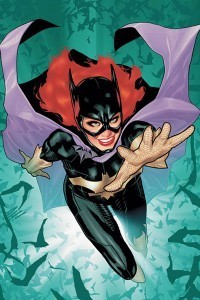 While the reasons for paralysing Barbara Gordon in the first place had been horrible and problematic, un-paralysing her brought new waves of protest. Barbara had been Oracle for more than 20 years, and readers were not happy about losing the most prominent, beloved disabled superhero in the DC Universe. There were also questions about youthening the character (to a recent college graduate) rather than keeping her as a mature mentor figure, and the accomplished woman she had become. While “all” the DC characters were supposedly youthened, this is a tradition usually applied more dramatically to female characters (Batman for instance remains an experienced paternal figure, whereas Wonder Woman has been remade young and innocent every decade or so). There is already a Batwoman, so if you take Oracle away from Barbara, she has nowhere to develop except to stay young and perky for eternity.
While the reasons for paralysing Barbara Gordon in the first place had been horrible and problematic, un-paralysing her brought new waves of protest. Barbara had been Oracle for more than 20 years, and readers were not happy about losing the most prominent, beloved disabled superhero in the DC Universe. There were also questions about youthening the character (to a recent college graduate) rather than keeping her as a mature mentor figure, and the accomplished woman she had become. While “all” the DC characters were supposedly youthened, this is a tradition usually applied more dramatically to female characters (Batman for instance remains an experienced paternal figure, whereas Wonder Woman has been remade young and innocent every decade or so). There is already a Batwoman, so if you take Oracle away from Barbara, she has nowhere to develop except to stay young and perky for eternity.
Finally, of course, there was the fact that Stephanie Brown was not only losing her series, but her place in the DC Universe. Since the New 52 reboot, there has been no canon reference to Stephanie or to Cassandra Cain, and no information as to whether they exist at all, and which (if any) of their past is still “canon.” Even diehard Barbara fans can’t miss the fact that all the male Robins and their backstories have been kept, while the history of the Batgirl legacy has been erased.
The new Batgirl title is written sensitively and with great skill by Gail Simone, a writer known for her feminist voice and particularly associated with Barbara Gordon from her Oracle days. It’s also important that neither the shooting nor the paralysis have been erased from the story – Barbara is depicted here as a former wheelchair user still getting used to the fact that she can walk again, and there is still a place for at least some of the Oracle history to be acknowledged. It’s also technically possible that a writer could acknowledge the history of the Batgirls who replaced Barbara during her time in the wheelchair, though as yet this has not been the case.
 There’s no denying that Barbara Gordon is the most iconic and well-known version of Batgirl – she is the version of the character who has appeared most often outside the comics: in the animated series, and the original live action series as well as on merchandise. A “Barbara” Batgirl even appeared in the movies, though Alicia Silverstone didn’t look much like our Babs, and was the niece of Alfred instead of being related to Commissioner Gordon. (I have a secret soft spot for Barbara Pennyworth, as I do for all the Batgirls.)
There’s no denying that Barbara Gordon is the most iconic and well-known version of Batgirl – she is the version of the character who has appeared most often outside the comics: in the animated series, and the original live action series as well as on merchandise. A “Barbara” Batgirl even appeared in the movies, though Alicia Silverstone didn’t look much like our Babs, and was the niece of Alfred instead of being related to Commissioner Gordon. (I have a secret soft spot for Barbara Pennyworth, as I do for all the Batgirls.)
To most people, comics readers or not, Barbara Gordon is Batgirl. But I would certainly argue that Batgirl is herself an iconic enough figure that she doesn’t have to be Barbara. Why is Batman the only one who is allowed to pass on his legacy, taking on and training all manner of sidekicks and children, while Barbara is not allowed to grow up?
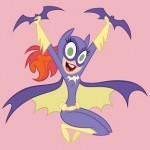 It’s not like we don’t get the chance to experience a younger Barbara-as-Batgirl in various other properties.
It’s not like we don’t get the chance to experience a younger Barbara-as-Batgirl in various other properties.
In the current Super Best Friends Forever series of DC Nation shorts, Batgirl is a fun loving teenager who rackets around town with mad gadgets and spring-loaded feet. In Ame-Comi Girls she takes the lead in a world without Batman or the Joker, with friends like Robin and Steel at her side, an evil antagonist in Duella Dent, and a growing wary alliance with Catwoman. There are great versions of Babs-as-Barbara in most of the animated series.
Then there’s Tiny Titans, which doesn’t make us choose between Barbara, Steph or Cass. We get all the Batgirls, and all the Robins, and they hang out with each other in the treehouse, and no one gets all het up about which of them are “iconic” or not. DC Comics has a rich and varied history, and it’s a shame they keep throwing away whacking great chunks of it in the name of appearing fresh.
I’m loving the current Batgirl series, but I would have much preferred it if it had been set in the past, as was the Superman Action Comics, allowing us to experience Barbara’s dashing and valiant adventures as a youngster, without losing the fascinating and mature character she had become as Oracle.
And I miss Stephanie Brown. A lot.
Where the Wonder Women Are:
0: Introduction
1: Black Canary
2: Rogue
3: Hawkgirl/Hawkwoman
4: Black Widow
5: Wonder Girl
6: Captain Marvel
7: Vixen
8: Abigail Brand.
9. Jubilee
10. Batwoman
11. Catwoman
12. Huntress
13. Robin
August 2, 2012
Friday Links is Fully Dressed
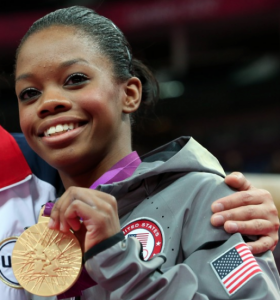 Look at me, taking a day off blogging about female superheroes! I’ll be back tomorrow to wind up “Batweek” with a rather long post about the history of Batgirl. Meanwhile, this week’s Friday Links post doesn’t refer to Huntress or Power Girl but our Australian Olympic athletes, many of whom are finally being allowed to dress for comfort rather than the male gaze.
Look at me, taking a day off blogging about female superheroes! I’ll be back tomorrow to wind up “Batweek” with a rather long post about the history of Batgirl. Meanwhile, this week’s Friday Links post doesn’t refer to Huntress or Power Girl but our Australian Olympic athletes, many of whom are finally being allowed to dress for comfort rather than the male gaze.
Other Olympic stories that caught my eye included British medal-winner Lizzie Armistead using her position to raise awareness of continuing sexism in the sporting industry, and the unfair focus on perceived faults with US teenager Gabby Douglas’ hair rather than her epic gymnastic skills and her gold medal. Bitch Magazine provides a rundown on the Olympics from a feminist point of view.
At Tor.com, an important discussion about geek girls and trolling – the complaints are getting louder, but so are the trolls.
On a similar story, Adrienne Kress talks about being a fake geek girl, and why accusations of ‘not being authentic’ do actual damage to women who are trying to fit in.
Justine Larbalestier has made a triumphant return to blogging this month, to celebrate the release of Team Human. I particularly enjoyed her posts on writing to the market, and the duty of care YA authors do or do not have to their teen audience.
Margo Lanagan talks about the pleasures of keeping what you read to yourself.
Gail Simone talks about Blade, the first of the Marvel Comics properties to make it big in Hollywood, and wonders why it keeps getting left out of the narrative.
Twenty years on, how do we feel about Buffy the Vampire Slayer the Movie?
And then there’s this. No words yet, but oh boy I’m getting excited. ROLL ON DOCTOR WHO YEAR 49!
Galactic Suburbia 65 Show Notes
The new episode is up! Download it through iTunes or from our Podbean site. 65 is a really big number, you guys!
 In which we discuss gender at the Olympics and sexual harassment policies at conventions, fight about whether we should read the comments, and Alisa reads more novels than Alex & Tansy PUT TOGETHER.
In which we discuss gender at the Olympics and sexual harassment policies at conventions, fight about whether we should read the comments, and Alisa reads more novels than Alex & Tansy PUT TOGETHER.
NEWS:
Readercon harassment discussion:
Masterlist & timeline of links
Cheryl looks at the practical side of developing harassment policies for conventions
Translation awards winners
Travel Fund Mark II sends two Swedish authors to WFC.
What Culture Have we Consumed?
Alisa: Earthly Delights by Kerry Greenwood, Naked in Death by J D Robb
Alex: Stargate Universe season 1; Ashes to Ashes season 3; Silently and Very Fast, Catherynne M Valente; Birds of Prey: Death of Oracle
Tansy: X-Men S.W.O.R.D No Time To Breathe; Uncanny X-Men: Dark Phoenix (The Ultimate Graphic Novels Collection, not Marvel Masterworks as I said in the podcast, worth also noting that the US are more than 20 issues ahead of Australia); Besieged, Rowena Cory Daniells
For next episode: send us your favourite examples of sport in SFF.
Please send feedback to us at galacticsuburbia@gmail.com, follow us on Twitter at @galacticsuburbs, check out Galactic Suburbia Podcast on Facebook and don’t forget to leave a review on iTunes if you love us!
August 1, 2012
Where the Wonder Women Are – #13 Robin
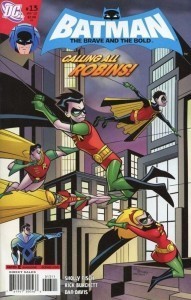 Robin the Boy Wonder is the best-known Batman sidekick character, though it’s probably fair to say that most casual Batman fans aren’t quite aware how many of them there have been. Yes, more than three!
Robin the Boy Wonder is the best-known Batman sidekick character, though it’s probably fair to say that most casual Batman fans aren’t quite aware how many of them there have been. Yes, more than three!
The original Robin, orphaned acrobat Dick Grayson, was portrayed as a teenager and young adult who had been adopted by Batman. He eventually outgrew the sidekick role, taking on his own superhero identity as Nightwing. His successors Jason Todd and Tim Drake had radically different personalities – Jason Todd was a street kid with a bad attitude who was so unpopular that when given the chance, comics fans voted overwhelmingly that he should be killed off, while Tim Drake represented Batman’s smarter side, a well-adjusted geek with great computer and information processing skills, who eventually, like Dick Grayson, left Batman’s side to become his own hero. (He’s currently known as Red Robin) The latest Robin, Damien Wayne, is Batman’s young and slightly sociopathic son to villainess Talia Al Ghul, who has been raised both evil and snarky.
While the public perception of Robin is that of a boy sidekick to the Dark Knight, there have actually been several young women who have also taken that role, though usually in alternate timelines, or for brief periods of time. It’s an important story to tell, in the context of women in comics, because of the very different ways in which Girl Wonders have been treated both by Batman and by DC Comics.
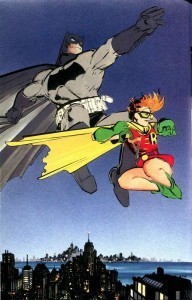 The first female Robin, Carrie Kelly, was brought to us by Frank Miller, the man who thought that Catwoman would be more interesting as a former sex worker. In The Dark Knight Returns (1986), a critically acclaimed graphic novel featuring a much darker and angrier version of Batman than had been seen before, thirteen-year-old schoolgirl and scout Carrie Kelly is rescued by Batman, and makes her own Robin costume in order to join him. She uses a slingshot and firecrackers as weapons, and wears large green tinted glasses instead of a mask.
The first female Robin, Carrie Kelly, was brought to us by Frank Miller, the man who thought that Catwoman would be more interesting as a former sex worker. In The Dark Knight Returns (1986), a critically acclaimed graphic novel featuring a much darker and angrier version of Batman than had been seen before, thirteen-year-old schoolgirl and scout Carrie Kelly is rescued by Batman, and makes her own Robin costume in order to join him. She uses a slingshot and firecrackers as weapons, and wears large green tinted glasses instead of a mask.
This Batman, who had retired after the death of Jason Todd, reluctantly allows this new sparky Robin to fight at his side, despite the pointed in-narrative commentary of other characters such as Superman and indeed the police, who include ‘child endangerment’ to their long list of charges against him.
Carrie is loyal, brave and above all, cheerful, exactly what this dark version of Batman needs to keep him going. Sadly she doesn’t exist beyond this self-contained continuity. In the sequel, The Dark Knight Strikes Again, Carrie was sixteen and still at Batman’s side, now calling herself Catgirl – still loyal, brave and cheerful, though a lot more violent than previously shown, but no longer claiming the name of Robin. She is also referred to as ‘jailbait’ within the comic, and many readers thought that she and Batman saying they loved each other was squicky (though Miller clarified in an interview that it was a father-daughter relationship, nothing more).
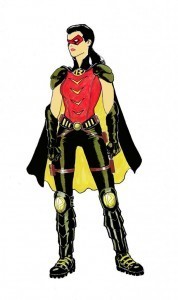 More than twenty five years later, DC Comics have brought two entirely different takes on an ‘alternate world’ female Robin. In World’s Finest, released early this year, we learned that the new version of Huntress is once again Helena Wayne, the daughter of Bruce Wayne/Batman from Earth 2, and that she used to be Robin alongside him, flying high tech planes and being generally awesome. Her life in Earth 2 is represented in a series of flashbacks drawn by Kevin Maguire, and from her combat suit to her skills and relationship with Batman, she seems to be treated as a female equivalent (and equal) to the original Dick Grayson Robin character.
More than twenty five years later, DC Comics have brought two entirely different takes on an ‘alternate world’ female Robin. In World’s Finest, released early this year, we learned that the new version of Huntress is once again Helena Wayne, the daughter of Bruce Wayne/Batman from Earth 2, and that she used to be Robin alongside him, flying high tech planes and being generally awesome. Her life in Earth 2 is represented in a series of flashbacks drawn by Kevin Maguire, and from her combat suit to her skills and relationship with Batman, she seems to be treated as a female equivalent (and equal) to the original Dick Grayson Robin character.
More recently, in another outside-continuity series, a new Robin has appeared in Ame-Comi Girls, which portrays the DC Comics universe as a world in which the only superheroes we see are the women (we don’t know for sure that there is no Batman, Superman etc. in this world, but the origins and backstories are starting to make it increasingly obvious that this is the case). The series has been developed around a set of very sexualised anime-style statuettes of DC women, and yet a combination of fun art and very clever writing by Jimmy Palmiotti and Justin Gray has turned it into a fantastic feminist superhero series.
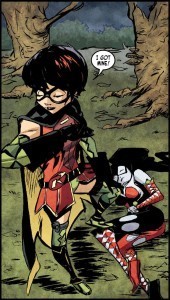 The Ame-Comi Robin appears to be a femme version of the standard Dick/Tim/Damien black-haired Boy Wonder. She has a short black haircut with a single ‘robin red’ streak, a sexy burlesque version of the old school Robin costume, and a wicked grin. However, Palmiotti and Gray chose to call her Carrie, presumably after Carrie Kelly, and to set her up as a best friend and cousin of Barbara Gordon’s Batgirl (the only Bat in Gotham). She’s a fun character who sums up all the classic Robin traits – loyalty, bravery and spunkiness.
The Ame-Comi Robin appears to be a femme version of the standard Dick/Tim/Damien black-haired Boy Wonder. She has a short black haircut with a single ‘robin red’ streak, a sexy burlesque version of the old school Robin costume, and a wicked grin. However, Palmiotti and Gray chose to call her Carrie, presumably after Carrie Kelly, and to set her up as a best friend and cousin of Barbara Gordon’s Batgirl (the only Bat in Gotham). She’s a fun character who sums up all the classic Robin traits – loyalty, bravery and spunkiness.
None of these Robins, however, are officially part of the continuity – with the possible exception of Helena, though Earth 2 was always used as a dumping ground for less conventional versions of characters, and it’s telling that she has no relationship at all with the Earth 1 Batman yet – who has, as of the New 52 reboot last year, retained what appears to be the entire history of his male Robins: Dick Grayson was the first, now starring in his own series as Nightwing; Jason Todd was the second, who died and eventually came back as the villain/morally dubious Red Hood, now starring in his own series Red Hood and the Outlaws; Tim Drake was the third, now starring as Red Robin in the ensemble comic Teen Titans. Damien Wayne, son of Batman and Talia Al Ghul, is the current Robin, featuring in all the Batman titles but especially Batman and Robin and Batman Inc.
But there’s one missing. One who is very, very notable by her absence. Buckle up, Batfans! It’s time to talk about Stephanie Brown.
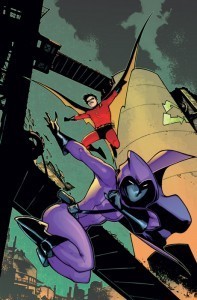 In 1992, Steph was introduced in Detective Comics (written by Chuck Dixon) as the teen daughter of The Cluemaster, a B-grade Batman villain. She created her own superhero identity, The Spoiler, specifically to wreck her Dad’s various criminal plots. She became a regular character in Dixon’s popular Robin series the following year as a friend, foil and occasional love interest for Tim Drake.
In 1992, Steph was introduced in Detective Comics (written by Chuck Dixon) as the teen daughter of The Cluemaster, a B-grade Batman villain. She created her own superhero identity, The Spoiler, specifically to wreck her Dad’s various criminal plots. She became a regular character in Dixon’s popular Robin series the following year as a friend, foil and occasional love interest for Tim Drake.
Steph was a working class hero, daughter of an absentee (mostly because of jail) criminal father, and a mother who was addicted to prescription medication. She maintained a fun and positive attitude towards life, however, and was a great, well-rounded character. Her friendship and on again, off again romance with Tim was very nicely drawn for the more-than-a-decade in which his series ran – in particular, her teen pregnancy storyline was met with positive critical acclaim.
In 2004, Tim Drake’s father discovered that he was Robin, and forced him to give up the costume. Steph decided to replace him in his old job, making herself a Robin costume and sneaking into the Batcave.
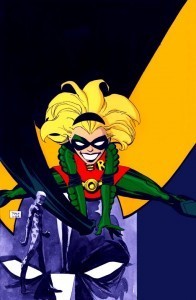 It was clear right from the start that just because there was a girl in the role of Robin didn’t meant that a feminist statement was on the cards, at least as far as the creators were concerned. Indeed, Steph was repeatedly belittled and undermined within the narrative. Batman was reluctant to accept her as Tim’s replacement, even questioning her worth after taking her through intensive training and supplying her with a professional Robin costume. Steph was portrayed as defiant, unable to take orders, and lacking in her predecessor’s competence.
It was clear right from the start that just because there was a girl in the role of Robin didn’t meant that a feminist statement was on the cards, at least as far as the creators were concerned. Indeed, Steph was repeatedly belittled and undermined within the narrative. Batman was reluctant to accept her as Tim’s replacement, even questioning her worth after taking her through intensive training and supplying her with a professional Robin costume. Steph was portrayed as defiant, unable to take orders, and lacking in her predecessor’s competence.
Oh, and then she was killed. Indeed, it was later revealed that the powers that be at DC Comics knew they were going to kill off Stephanie Brown when they made her Robin – she had always intended to be a sacrifice, and an example of a failed, incompetent superhero.
This is how it went down: Batman fired her for insubordination. Steph responded by stealing one of his long-term plans to deal with the entire Gotham criminal underworld and putting it into effect, without realising that she lacked all the information to pull it off. Gang warfare broke out, disaster ensued, and Stephanie was tortured horribly, her body depicted in a hideously objectified way in the artwork conveying said torture. She later died in hospital.
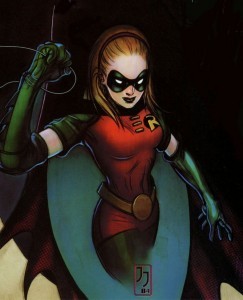 When Batman investigated, he discovered that Dr Leslie Thompkins, previously a sympathetic character, had deliberately chosen not to save Steph’s life so she could stand as an example to Gotham’s youth as what not to do.
When Batman investigated, he discovered that Dr Leslie Thompkins, previously a sympathetic character, had deliberately chosen not to save Steph’s life so she could stand as an example to Gotham’s youth as what not to do.
Stephanie’s death, her gratuitous and sexualised torture, and the subsequent emphasis on how she had basically deserved it through her own incompetence, was hugely upsetting for her legions of fans, especially a large number of female readers who felt that their hero had been thrown under the bus for no good reason. In particular, it was noticed that Steph was rarely mentioned after the storyline concerning her death was wrapped up – and unlike Jason Todd, her Robin costume did not hang in a memorial case in the Batcave.
It was hard to see that the different treatment of the martyred Jason Todd and the belittled Stephanie Brown was anything other than pure, unadulterated sexism. Indeed, she became a symbol of the appalling treatment of women in comics, not only as an example of the Women in Refrigerators phenomenon raised by Gail Simone (in which female characters are violently killed or hurt purely to advance the plots of male characters), but also of the general disrespect that many comics creators (and especially those making the executive creative decisions) have for female characters and female readers.
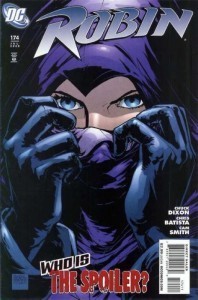 The website Girl Wonder, established by women such as Karen Healey and Mary Borsellino to discuss issues of feminism and sexism in the comics industry, was named in honour of Steph, and a campaign called Project Girl Wonder was established to request that DC Comics honour the character appropriately with a memorial case. Project Girl Wonder was officially retired in 2008 when Steph was brought back into the DC Universe, her death retconned as an event that had been faked by Dr Leslie Thompkins (though worth noting that this occurred after her horrible torture, so that aspect had not been erased). Not only did Steph fans have her back alive, but Dr Thompkins character had also been rehabilitated with this revelation.
The website Girl Wonder, established by women such as Karen Healey and Mary Borsellino to discuss issues of feminism and sexism in the comics industry, was named in honour of Steph, and a campaign called Project Girl Wonder was established to request that DC Comics honour the character appropriately with a memorial case. Project Girl Wonder was officially retired in 2008 when Steph was brought back into the DC Universe, her death retconned as an event that had been faked by Dr Leslie Thompkins (though worth noting that this occurred after her horrible torture, so that aspect had not been erased). Not only did Steph fans have her back alive, but Dr Thompkins character had also been rehabilitated with this revelation.
As far as many were concerned, it was a win, and after returning for some time to her Spoiler costume (there was never any question that she would be Robin again) Stephanie Brown went on to have a popular and successful run as Batgirl, which I will discuss tomorrow. Girl Wonder itself continues as a website featuring all manner of issues including campaigns to prevent harassment at conventions, to make comic shops female-friendly, and the celebration of iconic female characters. It’s now only one of a chorus of feminist blogs and critical commentators on the comics scene, who draw attention to problems as and when they arise.
Meanwhile, as of the recent New 52 reboot, Stephanie Brown has not been mentioned or appeared in comics (except for the out-of-continuity kids title Batman the Brave and the Bold in November 2011 where Steph and Carrie Kelly were two ‘future Robins’ who travelled back in time with the boys to save Batman’s life) and her fans have still not been told whether her history as Robin, as Batgirl or indeed as Spoiler “really happened” or not. Even a recent attempt by her Batgirl writer Brian Vaughn to include her as a female Nightwing in the out-of-continuity Smallville comic was quashed by those higher up in the company. Based on current information, Steph is the only canon Robin whose career has not been preserved in DC continuity. While this does mean her terrible death has also been erased, that is at a high cost if it means the history of the only canon Girl Wonder has been rendered invisible and irrelevant.
NEXT TIME: Batgirl!

Tiny Titans know how to share.
Where the Wonder Women Are:
0: Introduction
1: Black Canary
2: Rogue
3: Hawkgirl/Hawkwoman
4: Black Widow
5: Wonder Girl
6: Captain Marvel
7: Vixen
8: Abigail Brand.
9. Jubilee
10. Batwoman
11. Catwoman
12. Huntress
July 31, 2012
Where the Wonder Women Are: #12 Huntress
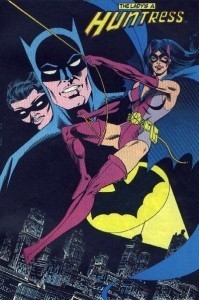 The original Huntress, Paula Brooks, was a super-villainess in the very early Golden Age of comics, but she’s not the character who is mostly associated with that name, and indeed her name was later retroactively changed to ‘the Tigress’ to save on confusion.
The original Huntress, Paula Brooks, was a super-villainess in the very early Golden Age of comics, but she’s not the character who is mostly associated with that name, and indeed her name was later retroactively changed to ‘the Tigress’ to save on confusion.
As I mentioned in the post on Catwoman, the real Huntress was a character who had her origins in Earth 2 in the 1960’s. The DC Comics multiverse allowed them to tell a variety of stories outside the main continuity, and Earth 2 was notable not only for preserving older and less fashionable versions of particular characters (such as the Golden Age Flash, Jay Garrick, or the Golden Age Black Canary, Dinah Drake) but also for allowing characters like Superman, Batman and Wonder Woman to age naturally, marry their sweethearts and have children of their own instead of remaining static as those in the main continuity often did.
Helena Wayne was not the daughter of Batman and Catwoman so much as the wealthy and privileged daughter of happy couple Bruce and Selina Wayne. Her world was not turned upside down until she was already an adult: her mother was blackmailed into one last costumed crime, and was killed due to Batman’s actions, leaving both Helena and her father grieving.
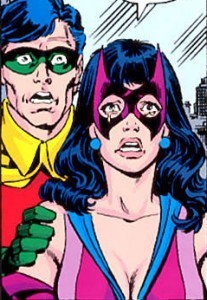 But while she was inspired by the death of her mother, and the hero figure of her father, Helena was not especially traumatised as Bruce himself had been by the loss of his parents at a much younger age, and she went on to have a rich and full life, balancing her life as a lawyer (in the same firm as Dick Grayson AKA Robin, her father’s former sidekick) and a costumed vigilante. Like Batman, Huntress relied largely on tools and gimmicks as well as martial arts ability. In particular, she was associated with the crossbow as a weapon.
But while she was inspired by the death of her mother, and the hero figure of her father, Helena was not especially traumatised as Bruce himself had been by the loss of his parents at a much younger age, and she went on to have a rich and full life, balancing her life as a lawyer (in the same firm as Dick Grayson AKA Robin, her father’s former sidekick) and a costumed vigilante. Like Batman, Huntress relied largely on tools and gimmicks as well as martial arts ability. In particular, she was associated with the crossbow as a weapon.
The Earth 2 Batman himself died in action before learning about his daughter’s own career as the Huntress. Dick Grayson considered taking over the Batman costume, but Helena convinced him otherwise, determined that they should keep their own identities, and allow Batman to be dead. To my mind, this means that for a large part of her career, Huntress was not just the Earth 2 equivalent of Batgirl, as might have been expected – she was the Earth 2 equivalent of BATMAN.
 Helena joined the Justice Society of America (the Earth 2 equivalent of the Justice League) and became particular friends with Power Girl (the Earth 2 version of Supergirl, Superman’s cousin). Her solo adventures mostly appeared in the pages of Wonder Woman as a back up feature, but she also appeared in All Star Comics and was briefly a member of the team Infinity Inc, who were all made up of the children of original Justice Society members. Helena was also often seen visiting Earth 1 for JSA/JLA team ups.
Helena joined the Justice Society of America (the Earth 2 equivalent of the Justice League) and became particular friends with Power Girl (the Earth 2 version of Supergirl, Superman’s cousin). Her solo adventures mostly appeared in the pages of Wonder Woman as a back up feature, but she also appeared in All Star Comics and was briefly a member of the team Infinity Inc, who were all made up of the children of original Justice Society members. Helena was also often seen visiting Earth 1 for JSA/JLA team ups.
Her early career and many of her adventures of the Huntress are collected in the trade paperback “The Huntress: Darknight Daughter” which I thoroughly recommend.
But – and here we go again – then came the Crisis of Infinite Earths, and the formal destruction/merging of the DC multiverse in 1985. No longer happy with telling stories across multiple continuities, the company was keen to streamline its narrative, and that meant the sacrifice of many characters. In the new continuity, many of the Justice Society members were now rewritten as the previous generation’s heroes who observed and played a mentoring role from their retirement chairs.
Helena Wayne, however, wasn’t going to work in this new continuity – certainly not as the adult daughter of Batman and Catwoman, or as an older “Golden Age” character, as she wasn’t part of that tradition. Like many other characters, she was killed in action during the Crisis battle, and once the reboot kicked in, no one remembered she had ever existed. Before she was killed, however, both she and “her” Dick Grayson got to experience the horror of realising that their world had gone, and no one remembered either of them.
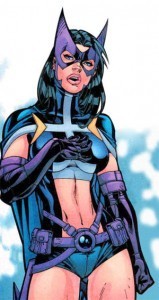 In 1989, The Huntress made a return to the DC universe. Helena Bertinelli looked very similar to Helena Wayne, but had an entirely different character and personality. The Italian daughter of a mafia boss whose family was wiped out in a hit (because, you know, ALL Italian people are connected to the mob, that’s not xenophobic at all), she is much darker, tougher and more trauma-driven than her previous incarnation.
In 1989, The Huntress made a return to the DC universe. Helena Bertinelli looked very similar to Helena Wayne, but had an entirely different character and personality. The Italian daughter of a mafia boss whose family was wiped out in a hit (because, you know, ALL Italian people are connected to the mob, that’s not xenophobic at all), she is much darker, tougher and more trauma-driven than her previous incarnation.
The modern Huntress costume is notable for retaining its similarity to the Bat and Cat legacy costumes, apart from the large white cross which identifies the character as Bertinelli rather than Wayne, and indicates her Catholicism. It has also consistently bared her midriff for several decades. It always seemed to me the height of hubris to bare the midriff of a character whose signature weapon is the crossbow. But Helena IS pretty hard, chances are her mighty abs would just deflect any missiles that came her way.
Helena Bertinelli occupied a strange space in the comics, as a “new” character who looked and felt like she should be part of the Bat-family, but was not endorsed or even liked by Batman, who disapproved of her violent nature – the implications inherent in her use of the crossbow are at least not ignored here as they were in the Earth 2 days where were all a bit ‘lalalala jolly adventure, shoot someone in the head, lalala.” Helena has forged her own friendships with other Bat-characters like Dick Grayson’s Nightwing (whom she occasionally romances), Tim Drake’s Robin, Barbara Gordon’s Oracle and even Catwoman, as well as friendships with many of her “former” colleagues in the Justice Society all without reference to her previous (non-)existence.
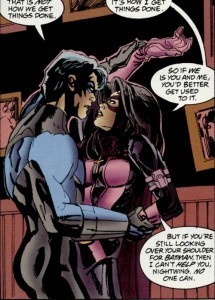 Over the next twenty years, Helena Bertinelli created her own legacy, distinct from that of Helena Wayne. She had her own mini-series early on which focused on the Mafia aspect of her backstory, and set her up as a streetwise vigilante. She joined the Justice League International as the token ‘person without a sense of humour’ but tended not to stay for longer than short periods, mostly because of Batman’s suspicion of her and his continuing association with the League.
Over the next twenty years, Helena Bertinelli created her own legacy, distinct from that of Helena Wayne. She had her own mini-series early on which focused on the Mafia aspect of her backstory, and set her up as a streetwise vigilante. She joined the Justice League International as the token ‘person without a sense of humour’ but tended not to stay for longer than short periods, mostly because of Batman’s suspicion of her and his continuing association with the League.
In the massive No Man’s Land Batman storyline of the late 90′s, in which Gotham City fell apart as an abandoned war zone, Helena not only stayed as Huntress, helping and defending people to the best of her ability, but also briefly took on a ‘Bat’ costume as well, because she felt the city needed to think that Batman was still around. There was a marvellous scene in which she dared a bunch of thugs to consider whether or not the Bat had ALWAYS been female, and no one had ever admitted it before. Batman briefly allowed this new Batgirl to continue wearing “his” symbol and to fight under his own command, but later bullied her into giving the costume back, claiming now that it was her uncontrollable emotions that made her unfit to represent him. He promptly handed the costume on to young, silent assassin Cassandra Cain.
Huntress continued to be portrayed as a loner, someone who isn’t quite allowed into the “family” of costumed characters in Bruce Wayne’s inner circle. She maintains her connection to Gotham City, though, possibly entirely to spite him.
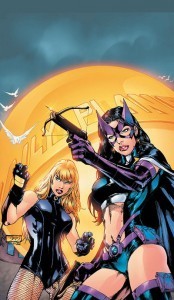 Helena found a place in the Birds of Prey, alongside Oracle and Black Canary, and became one of the central ongoing characters of that team. She also featured in the short-lived Birds of Prey TV series, played by Ashley Scott, though the TV version was not Helena Bertinelli but “Helena Kyle,” daughter of Batman and Catwoman once again.
Helena found a place in the Birds of Prey, alongside Oracle and Black Canary, and became one of the central ongoing characters of that team. She also featured in the short-lived Birds of Prey TV series, played by Ashley Scott, though the TV version was not Helena Bertinelli but “Helena Kyle,” daughter of Batman and Catwoman once again.
Other TV appearances include the excellent, Bertinelli-authentic version of Huntress in Justice League Unlimited, where she attempts to avenge the deaths of her parents, and becomes romantically involved with the Question; and also the rather less authentic appearance of the Huntress in Batman: the Brave and the Bold where she is a college professor, and indicates some romantic interest in Batman (ewwwww!).
I think it’s also worth noting that the post-Crisis Catwoman has developed along very similar lines to Helena Bertinelli, with a noir sensibility and a focus on storylines involving mobsters, drugs and the seedier side of the DC streets. Indeed, the Brubaker version of Catwoman from the 2000s felt to me very similar in tone and content to the Huntress mini-series of the late 80’s, with Catwoman set up as far more of a street protector and vigilante than an actual cat burglar.
 In recent years, Helena Bertinelli acquired an odd friendship with Power Girl, who was dealing with her own identity crisis thanks to memories of their former life in Earth 2 (which had been restored to DC Comics as of the Infinite Crisis event) and clung to Helena as the closest thing she could get to her own former best friend, Helena Wayne.
In recent years, Helena Bertinelli acquired an odd friendship with Power Girl, who was dealing with her own identity crisis thanks to memories of their former life in Earth 2 (which had been restored to DC Comics as of the Infinite Crisis event) and clung to Helena as the closest thing she could get to her own former best friend, Helena Wayne.
And then (another familiar reboot pressure point!) came the New 52 of 2011. Neither Huntress nor Power Girl were featured as part of the early line up of titles last year, but within a month or two of the reboot, Huntress appeared in her own mini-series. It all looked very promising – for the first time since she gave up wearing a leotard to fight crime in, her midriff was protected by a far more practical version of her signature costume, and the comic so beautifully drawn by Marcus To featured glorious Italian scenery along with a fairly standard “Helena Bertinelli” plot involving people smuggling and the suffering of women in the modern slave trade. Gritty violence, drugs, mob connections and crossbows, all just what you might expect.
 Except that it wasn’t. Because as revealed at the tail end of the mini-series, this wasn’t Helena Bertinelli at all. The twist was that Earth 2 had been sneakily rebooted as well, and no one knew about it yet… no one except Power Girl and Huntress, who were in fact the Earth 2 versions of themselves, stuck on Earth 1.
Except that it wasn’t. Because as revealed at the tail end of the mini-series, this wasn’t Helena Bertinelli at all. The twist was that Earth 2 had been sneakily rebooted as well, and no one knew about it yet… no one except Power Girl and Huntress, who were in fact the Earth 2 versions of themselves, stuck on Earth 1.
The Worlds Finest ongoing series was launched early this year, answering some of the WTF! questions that had been running around the internet. This Helena, it turned out, was very much Helena Wayne, daughter of Batman (and we assume, Catwoman), though the superhero identity she had held in Earth 2 was Robin, making her officially a partner to her father (which I have to say made me go AWWWW like nothing else – Helena has never had that before in any of her previous incarnations!).
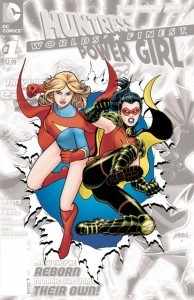 Now stuck in a world which already has a Supergirl and a Robin, Karen and Helena created new identities for themselves, and while Karen/Power Girl has been busy building a tech company and trying to find their way home, Helena has been wearing vigilante purple and saving the downtrodden. Once more she’s a character who should have a Bat-family legacy, but instead has to operate on her own, away from the support of the Gotham gang – but this time, she knows it.
Now stuck in a world which already has a Supergirl and a Robin, Karen and Helena created new identities for themselves, and while Karen/Power Girl has been busy building a tech company and trying to find their way home, Helena has been wearing vigilante purple and saving the downtrodden. Once more she’s a character who should have a Bat-family legacy, but instead has to operate on her own, away from the support of the Gotham gang – but this time, she knows it.
Despite the positives of this new series, the reboot has proved highly controversial. Helena Bertinelli’s Huntress has a strong following of readers who had never even heard of the Helena Wayne version of the character, and feel betrayed at the cavalier loss of decades of backstory and development. It didn’t help that ‘Bertinelli’ is revealed in Worlds Finest Issue #1 as the identity of “a dead woman” which Helena Wayne has been using falsely for some time – this felt for many readers like they were being kicked when already down.
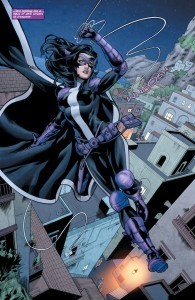 I sympathise deeply with those readers who have lost their Huntress. It sucks when “your” version is taken away from you – having a favourite character killed off is bad enough, but having one rebooted out of reality is harsh, and the New 52 has featured a great many blows for fans of female characters in particular.
I sympathise deeply with those readers who have lost their Huntress. It sucks when “your” version is taken away from you – having a favourite character killed off is bad enough, but having one rebooted out of reality is harsh, and the New 52 has featured a great many blows for fans of female characters in particular.
But for me personally, while I have always enjoyed Helena Bertinelli, it feels like I have “my” Huntress back, and a far more interesting and complex take on the character than the pre-Crisis comics allowed for. If the art was less hit-and-miss (George Perez is really not capable of drawing women who look like they belong in this century, it seems, though the flashback sequences by Kevin Maguire are wonderful) Worlds Finest would be a serious contender for my favourite current female-led comics title.
I can wait.
* * *
Where the Wonder Women Are:
0: Introduction
1: Black Canary
2: Rogue
3: Hawkgirl/Hawkwoman
4: Black Widow
5: Wonder Girl
6: Captain Marvel
7: Vixen
8: Abigail Brand.
9. Jubilee
10. Batwoman
11. Catwoman


